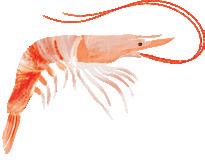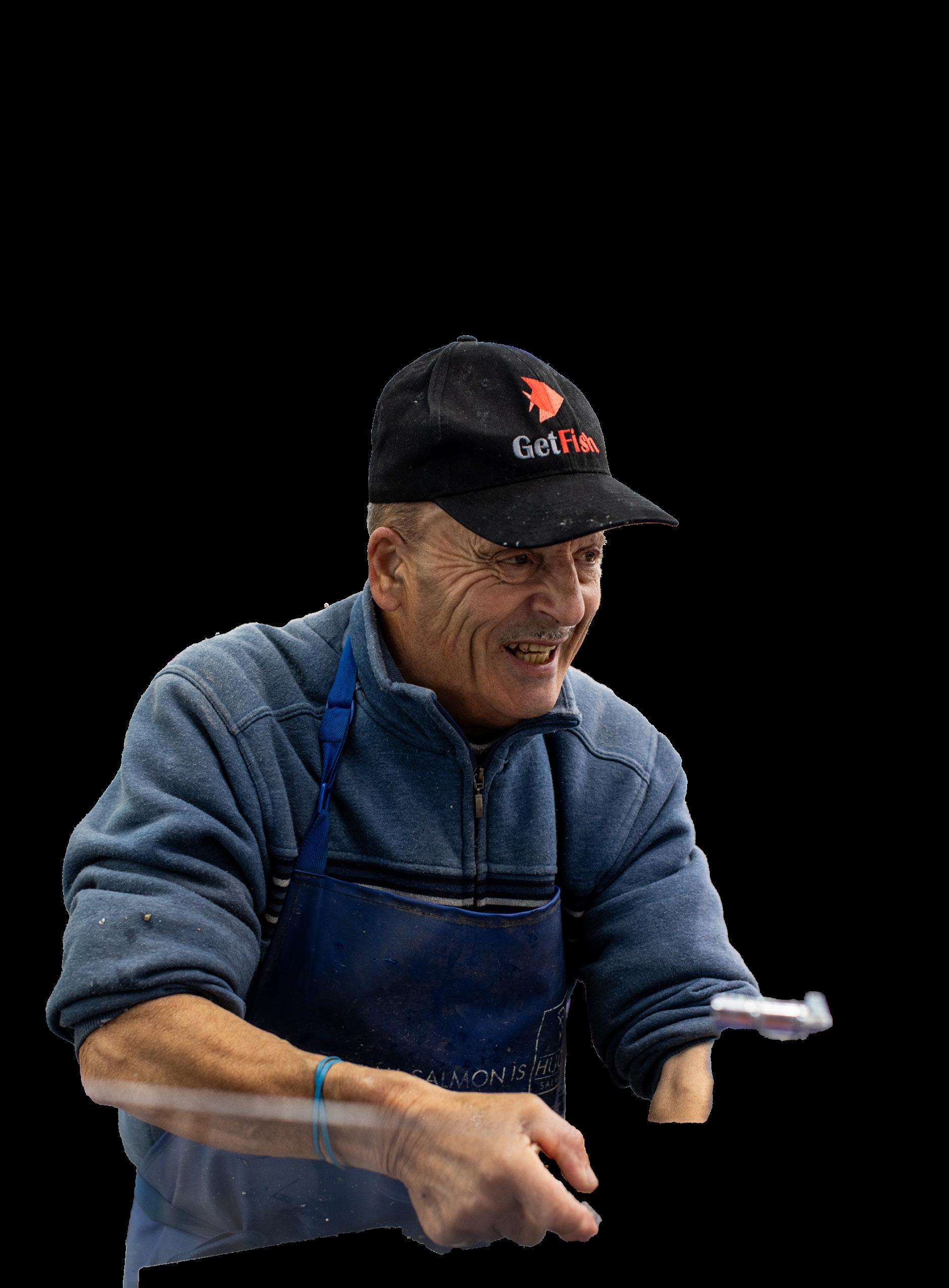

MORE THAN A FISH MARKET SEASONAL GUIDE
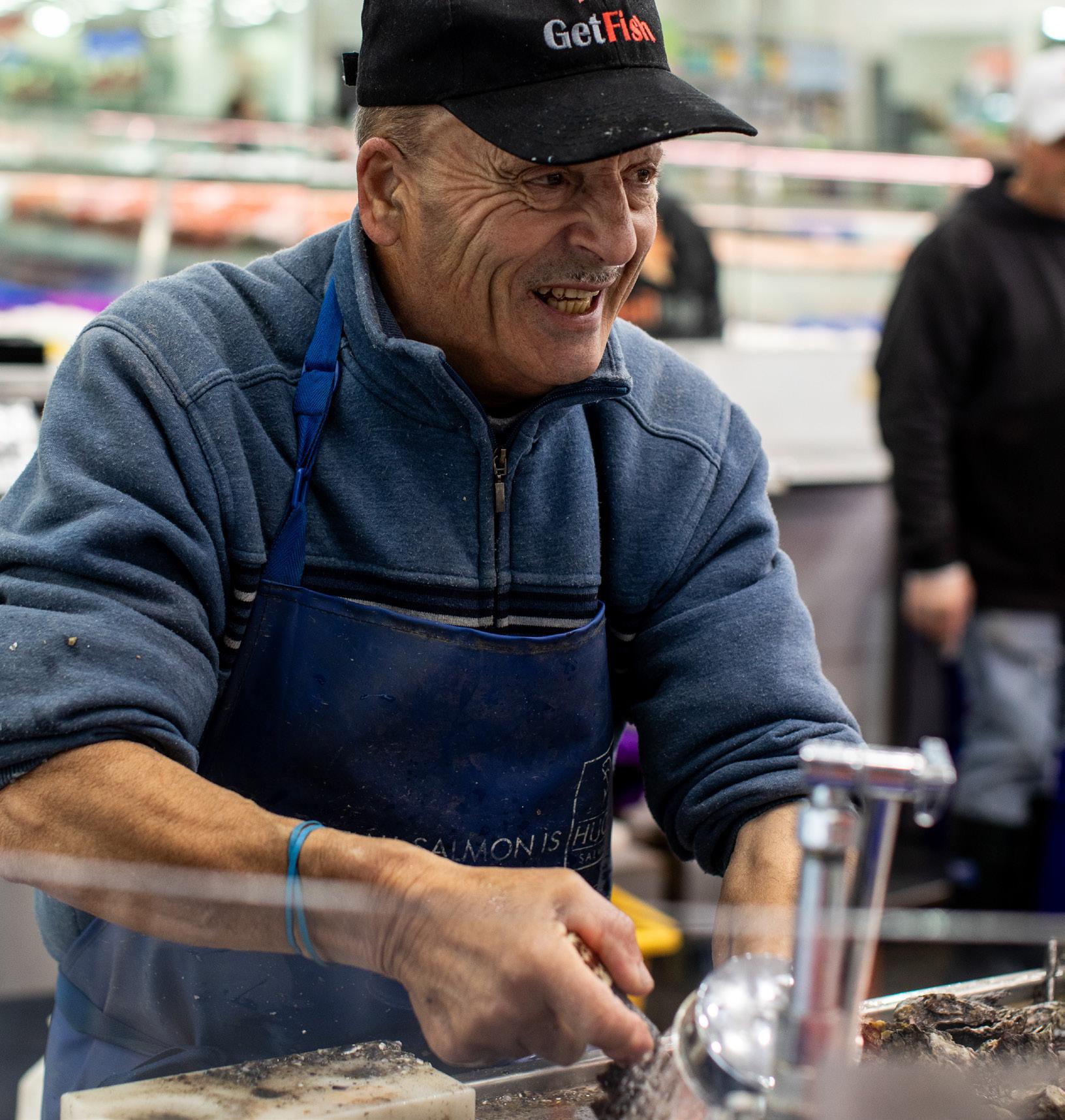

ALL ABOARD!
You’re holding the key to making the most of the season’s freshest seafood.
This guide is your go-to source for the latest seafood tips, tricks, recipes, and trends. And who better to keep you informed than Australia’s Home of Seafood?
We hope it inspires you to enjoy more seafood on your plates this winter!
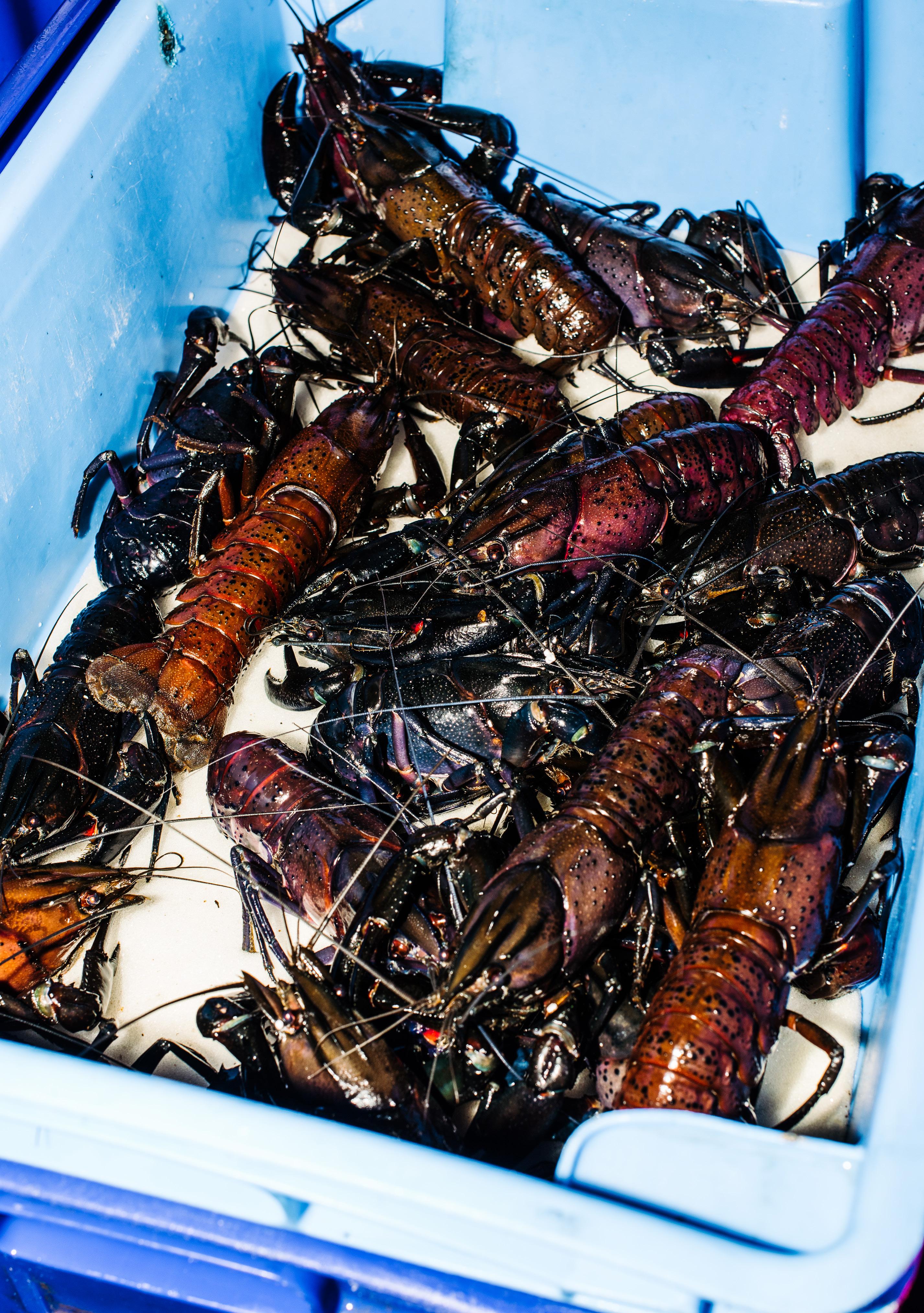
OUR FAVOURITE SEAFOOD SPECIES FOR WINTER
We all think about buckets of prawns or fish fillets on the barbie during summer but winter is actually one of the best times to enjoy Australia’s abundance of seafood.
Just like a lot of us, many marine species use winter as an opportunity to put on a bit of extra weight. This means thicker, juicier fillets, and oodles of lovely fat that’s rich in omega-3, one of our best winter defences. Some species even migrate to shallower, warmer waters, making it easier and cheaper to sustainably harvest them.
Here are some of our favourite species for winter.
MIRROR DORY
Arguably just as delicious as its more famous cousin John, Mirror Dory is one of our go-to species for winter. These fish come into their peak in the cooler months when the fillets thicken and become lovely and juicy.
Due to the abundance of Mirror Dory, and the ease with which it can be caught, especially during winter when they move into the shallower reaches of the continental shelf, it is typically a low-priced fish, sometimes retailing for up to half the price of John Dory.
Try it pan fried with a reduced citrus sauce. There’s a fab recipe in our cookbook, A Fish for All Seasons.
AUSTRALIAN SARDINES
So underrated but so delicious! Sardines are one of the healthiest fish to eat, available year round, and winter is their peak season.
We recently had the fabulous Julia Busuttil Nishimura do a class at Sydney Seafood School and her Sicilian-style Sardines stuffed with pine nuts, orange, mint, parsley and currants was the business. You can find the recipe in her fabulous book Good Cooking Every Day.
Use pre-butterflied fillets to make cooking with them quick and easy. Many of our retailers sell Australian Sardines in packets of pre-butterflied fillets, or ask your fishmonger do the filleting hard yards for you.
ALFONSINO
At this time of year, we prefer to skip the BBQ in favour of a warming oven, so fish that lend well to being whole roasted, like Alfonsino, are hard to beat.
During the cooler months Alfonsino are in abundance and premium quality. This bright red fish is stunning to look at and even better to eat. It has a huge mouth, allowing it to eat a diverse diet which gives it a rich flavour profile. A fish that tastes this good doesn’t require much effort to cook and is best steamed or baked whole then placed in the middle of the table for everyone to enjoy.
BLUE MUSSELS
Available year round, but exceptionally good eating in winter, Blue Mussels are a delicious, sustainable seafood choice.
With their sweet, briny flavour and tender texture, they’re perfect steamed, grilled, or added to warming soups or pastas. Rich in protein, omega3s, and essential minerals like iron and B12, Mussels support heart and brain health while being low in fat and calories.
When shopping, look for brightly coloured, firm, intact, lustrous shells that are closed or close when tapped or gently squeezed, and a pleasant fresh sea smell. They’re also available in convenient vacuum sealed packs.
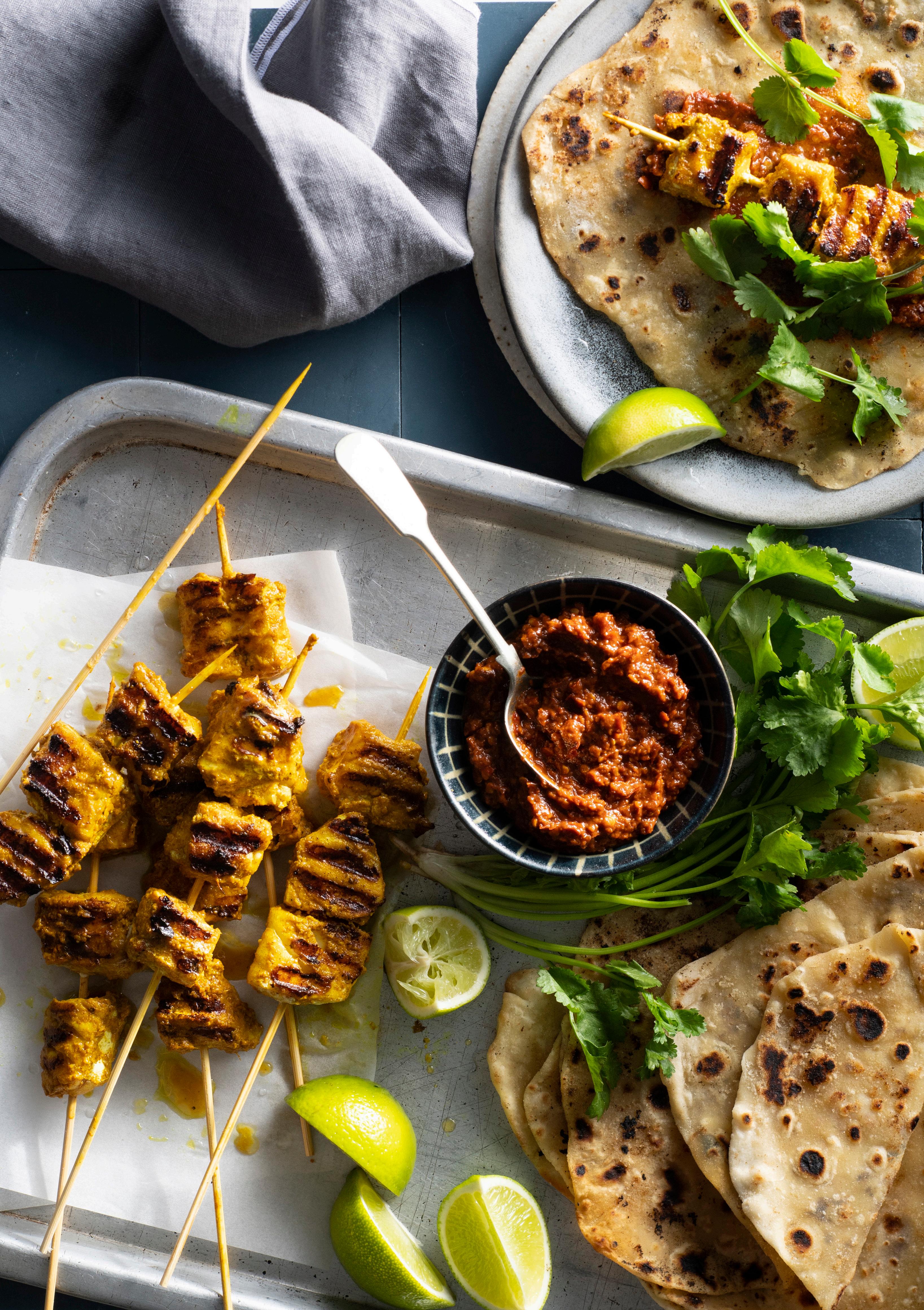
PINK LING
This denizen of the deep is eaten year-round, chiefly due to how meaty and versatile the fillets are.
Due to the fat in the flesh, the meat is excellent slow cooked in pies, curries and soups. We also love it threaded onto skewers and grilled on the barbecue or as the star of an epic fish burger. Dip fillets in buttermilk and douse in seasoned flour then deep-fried to super crispiness. Add a caper and cornichon tartare and you’re in burger heaven.
Hot Pink Ling Skewers with Roti Wraps & Chilli Sambal from ‘A Fish For All Seasons’, the official Sydney Fish Market Cookbook. Get your copy at sydneyfishmarket.com.au
WELL
Seasoned.
See our top retailer picks this season, perfect for hearty dishes, cosy nights in, and showcasing the best of what’s hot this winter.
FENNEL
Sweet, crisp, and beautifully aromatic, fennel is in peak form right now. Shave it raw into salads with citrus, or roast until caramelised for the perfect side to rich seafood dishes.
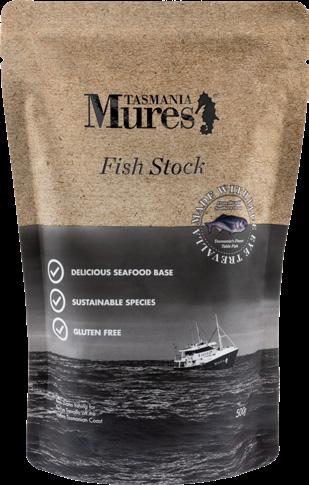
MURES FISH STOCK
An absolute pantry essential. Made from premium seafood, this rich stock is the perfect base for risottos, soups or a warming bouillabaisse. Pick up a few and keep them handy for quick, flavourful meals.
MACHI MACHI

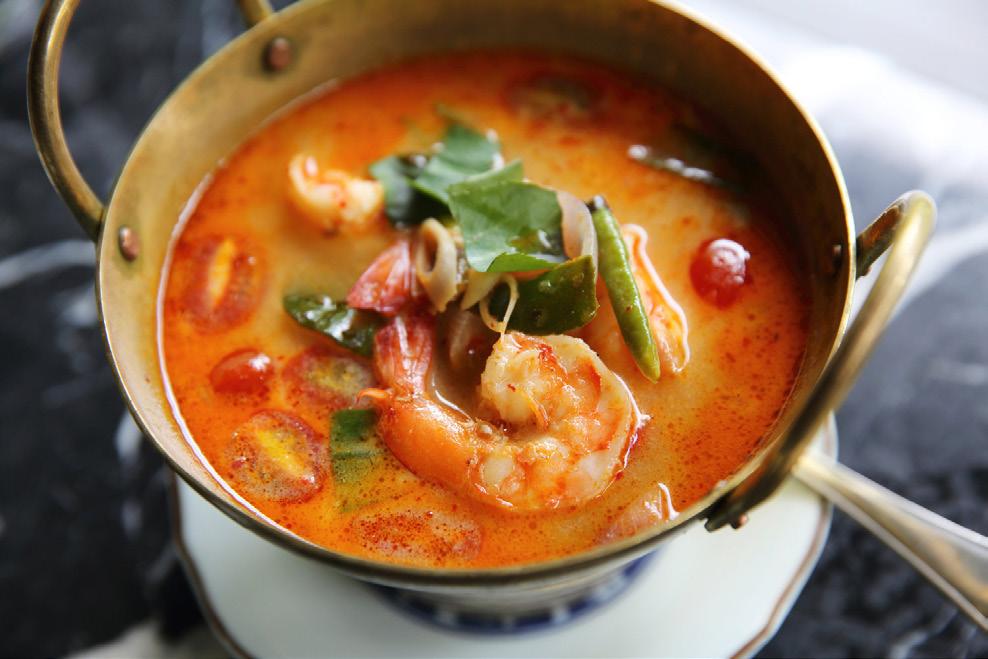
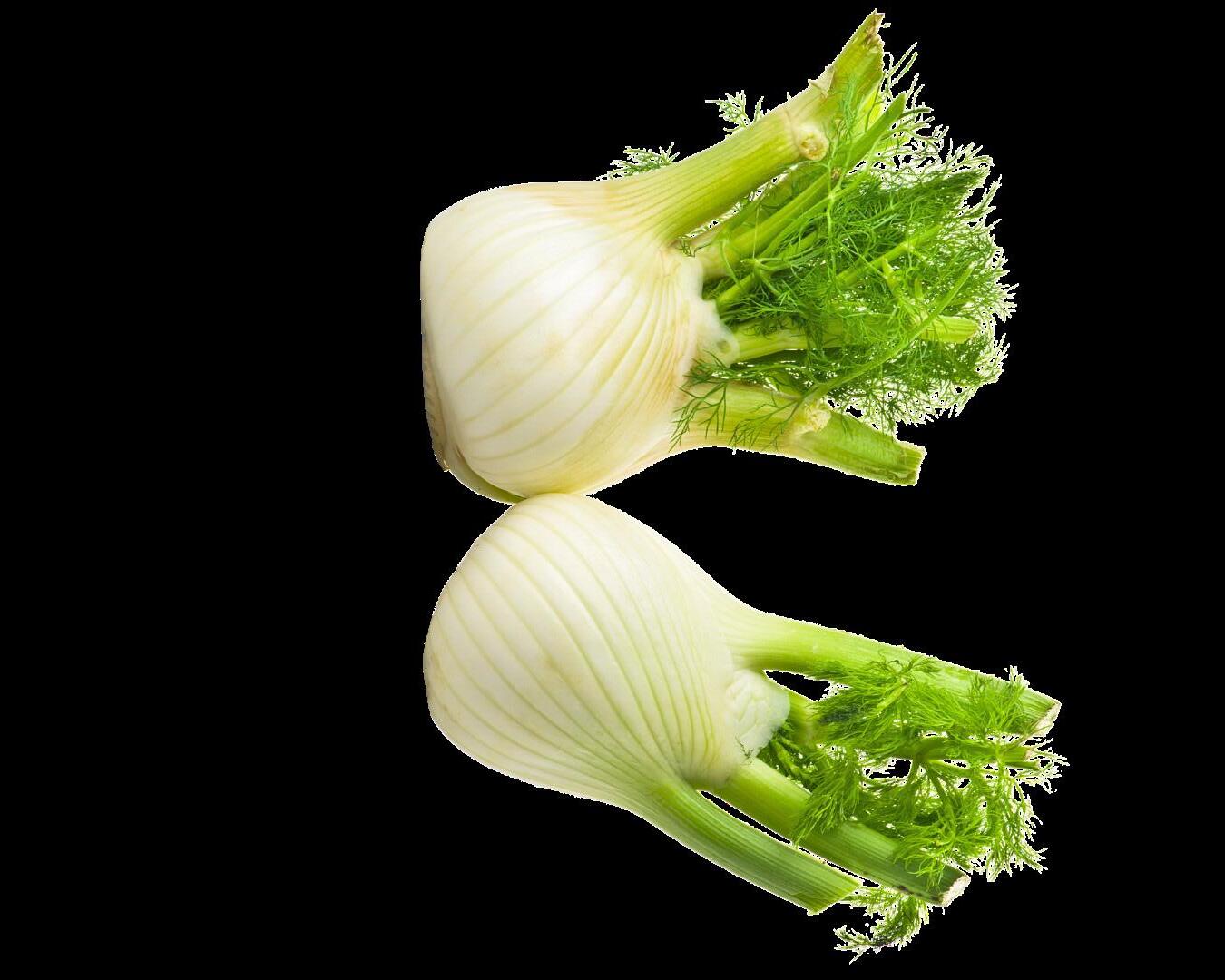
FILLETS
This firm, versatile white fish is ideal for winter comfort food. It holds its shape beautifully when battered, baked, or added to curries and pies. A reliable all-rounder for your weeknight dinners.
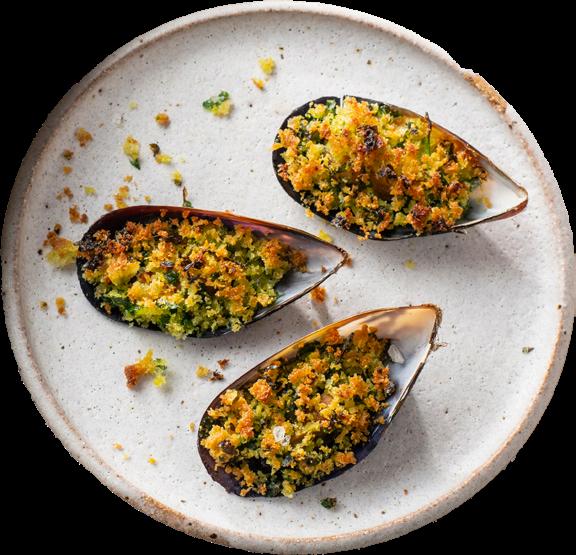
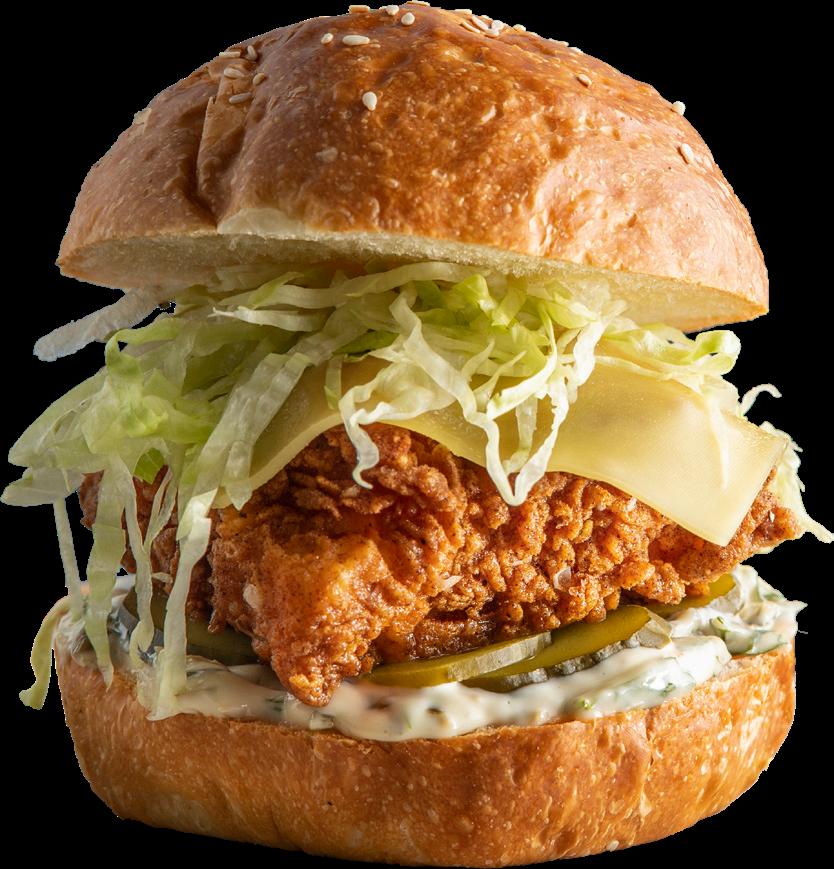
Need a pre-shop warm-up? Machi Machi has you covered with their Hot Chocolate Latte with Cream Cheese Foam. Sip as you stroll the market for all your seafood shopping needs.
MUSSELS
Quick to cook and full of briny goodness, mussels are a winter winner. Steam them in white wine and garlic, or go for something bold with a spicy tomato broth.
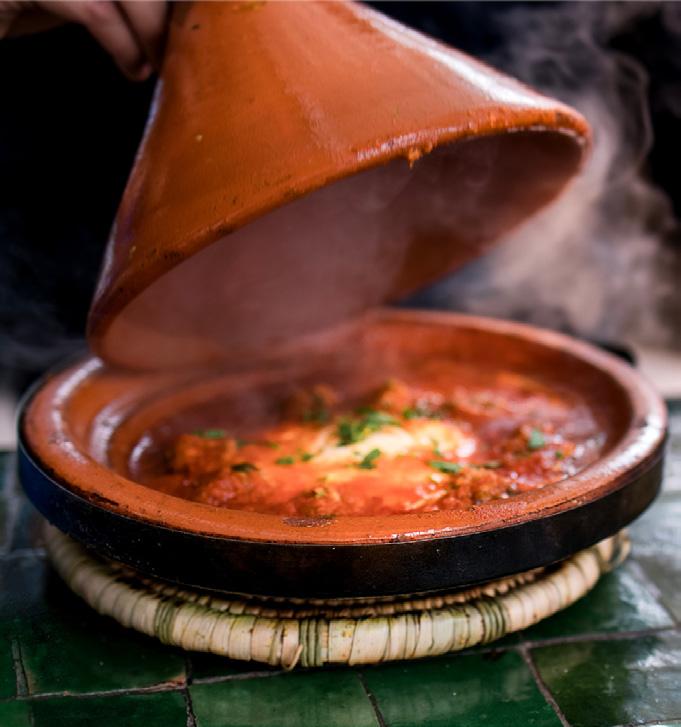

This traditional pot isn’t just for show, it’s a slow-cooking superstar. Great for winter stews and perfect for layering seafood, spices, and seasonal veg to build deep flavour. TAGINE
BOATSHED
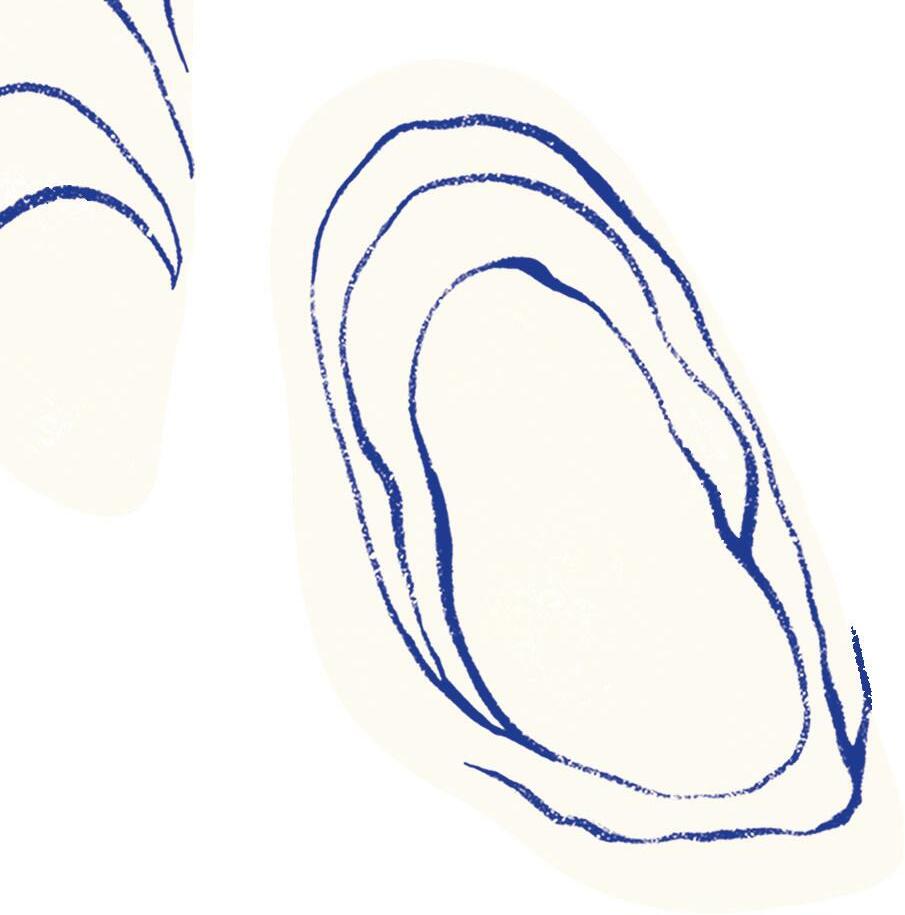
National NAIDOC Week celebrations are held across Australia in the first week of July each year (Sunday to Sunday), to celebrate and recognise the history, culture and achievements of Aboriginal and Torres Strait Islander peoples.
As part of Sydney Fish Market’s Reconciliation Action Plan, we’ve been enjoying learning about the rich Aboriginal history of our area.
To mark NAIDOC week, we wanted to share a snapshot of that history, and we are looking forward to having many more opportunities to honour First Nations heritage and culture at the new Sydney Fish Market.
Pre-colonisation, Sydney Fish Market’s location (Blackwattle Bay) was a significant one for Aboriginal people as it provided access to fresh unpolluted water as well as a saltwater source for seafood.
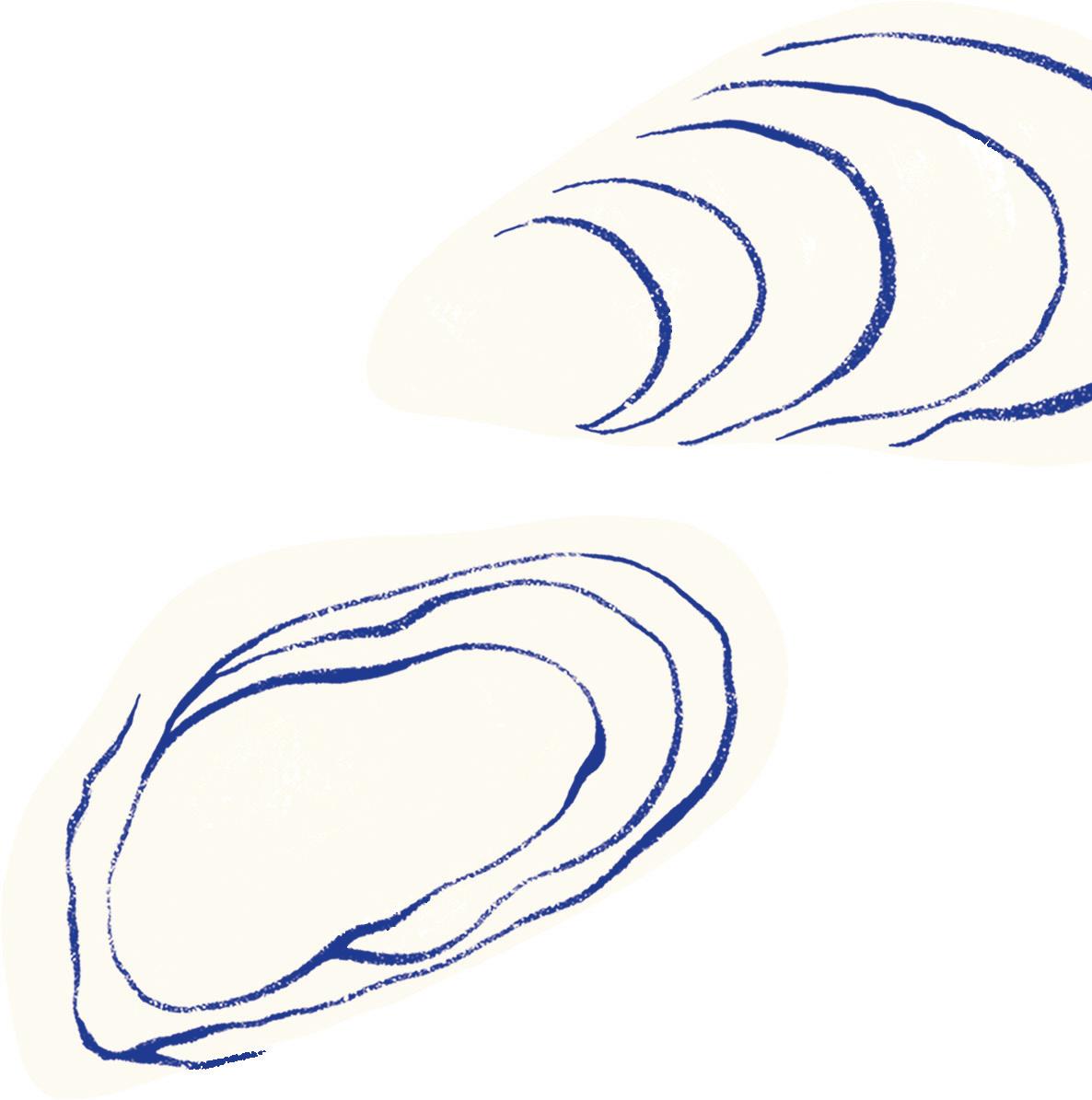
6 – 13 JULY 2025
NAIDOC Week
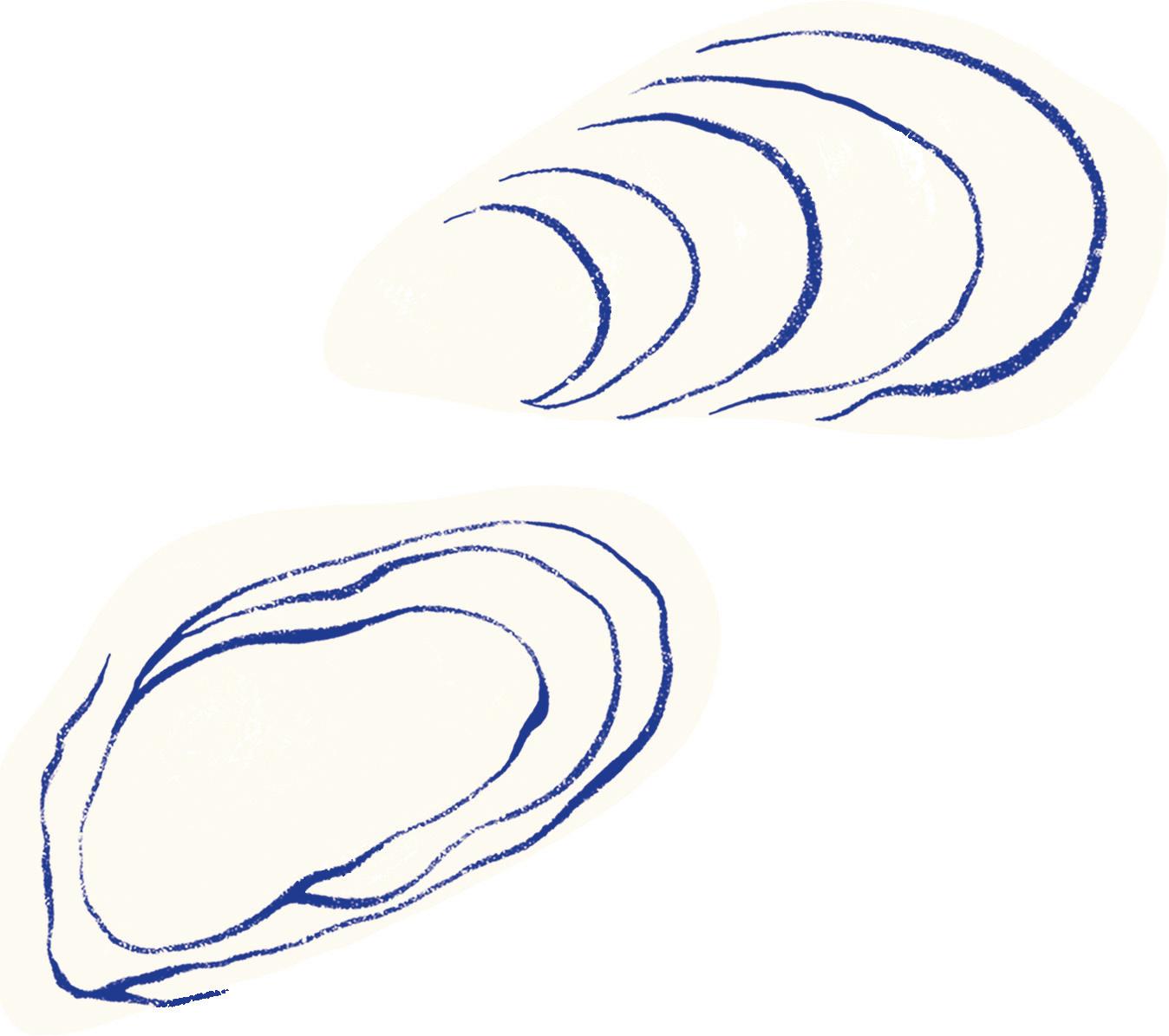
Blackwattle Bay now sits at the end of what used to be Blackwattle Creek, which was a major source of fresh water for local Aboriginal people. As the creek reached the harbour, it became a tidal brackish system that held large amounts of bivalves. The surrounding land was dense scrub shaded by a large colony of Ironbarks, of which the last surviving member still stands on the grounds of St John’s Anglican church in Glebe.
Traditional owners hunted game and harvested plants, but archaeological evidence suggests that they depended heavily on the waters of Sydney Harbour to survive. Methods of fishing varied, but evidence shows a strong preference for eating Mullet, Bream, Snapper, Flathead, Stingrays, Cockles, Oysters, Crabs, Octopus, and the occasional Turtle.
A fishing vessel used by residents of Sydney Harbour was the bark canoe (called a ‘nawi’). While the men fished with spears from the shore, the women would build cooking fires on clay beds in their nawis before paddling out, often carrying a baby, in all but the roughest conditions. The fires provided warmth for the fishers and cooking coals for the fish, and the women were able to meet back on shore with their families and enjoy already cooked fish. They fished as often as possible, so much that it was said that day or night, Sydney Harbour was dotted with glowing fires trailing threads of smoke.
Aboriginal people in the Sydney area historically gathered and traded local produce including sour native currants prized by colonists for making jams, jellies and scurvy treatments; native sarsaparilla, used to brew tea; native flowers; and seafood. However, as Glebe and surrounding lands were increasingly privatised and settled by Europeans, Aboriginal people were displaced and gradually lost access to these resources and trading opportunities.
Early colonists used the Glebe area for pig and cattle farming, or other early industry. Eventually the increased traffic and livestock compacted the soil and turned Blackwattle Stream, the community’s freshwater source, into an impassable swamp. Many years later, the swamp was drained to provide land for recreation - giving us Wentworth Park, Harold Park, and Jubilee Oval.


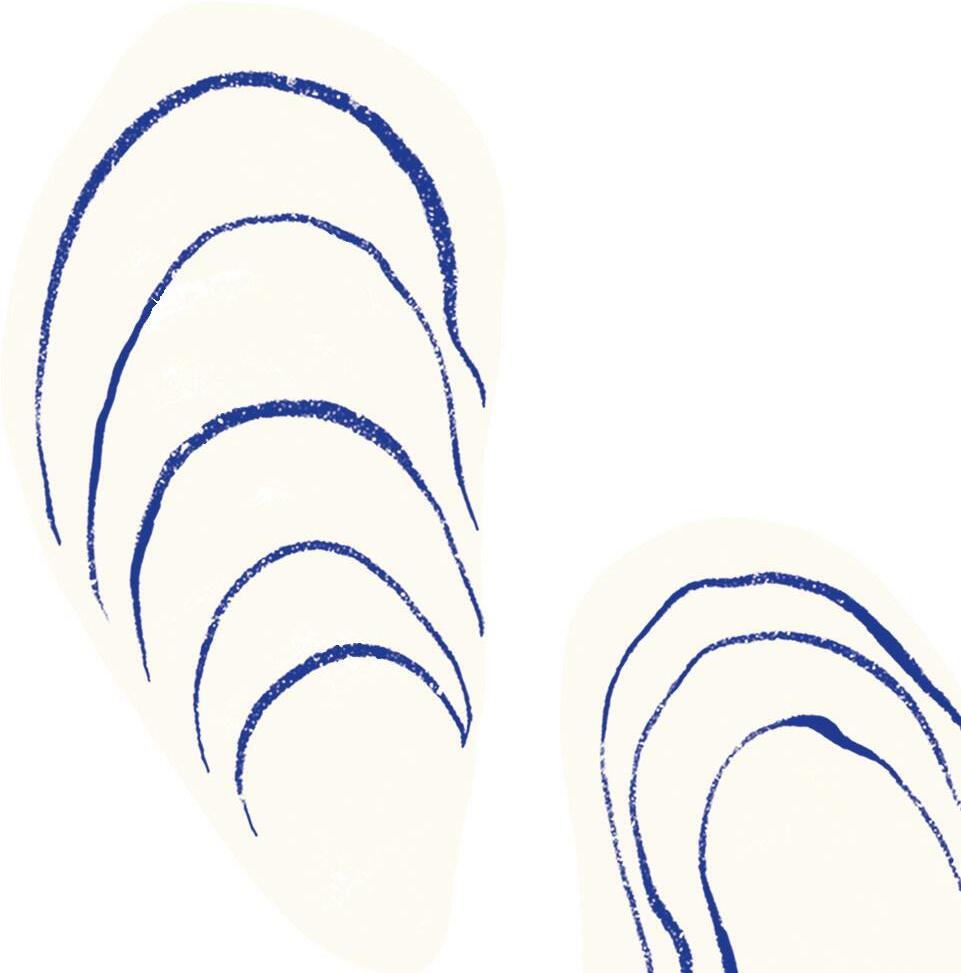
Blackwattle
International Day of the Fisherman,
June 29th is a day to honour the sacrifices and hard work of fishers and aquaculturalists worldwide. We are fortunate at Sydney Fish Market to do business with so many committed and hardworking men and women who have dedicated their lives to professional fishing. Without them, there’d be no seafood, and no Sydney Fish Market!
To mark the day, we sat down with SFM’s resident Seafood Educator, Mike Huls to get an insight into what it’s like working as a fisher. While we keep him busy guiding tours these days, Mike has an incredible background working as a commercial fisherman all over the world!
So Mike, we managed to pull you away from fishing to work at SFM (lucky us!), tell us about your previous jobs as a fisher – where did you work and what species did you catch?
I have been lucky enough to work in a handful of different fisheries around the Pacific.
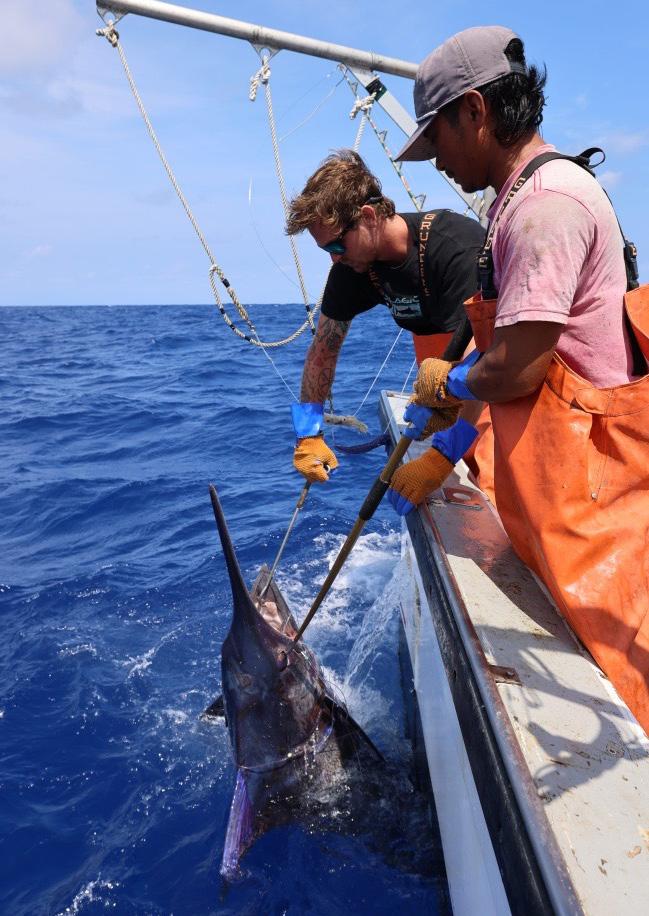
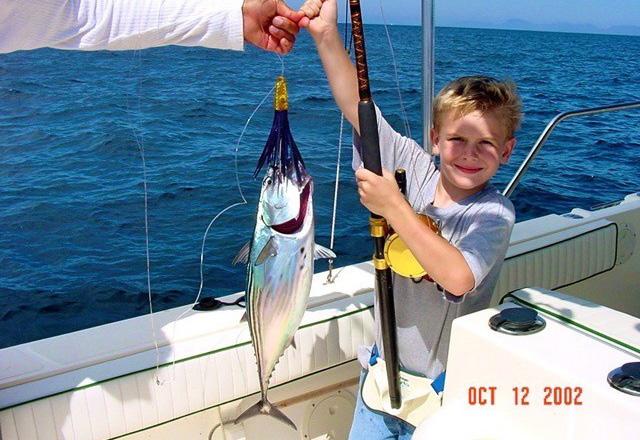
I started my commercial fishing career gillnetting Sockeye Salmon in Alaska’s Bristol Bay. From there I jumped into the Hawaiian pelagic longline fleet, fishing for Tuna in the middle of the Pacific Ocean.
I spent a couple of seasons on a boat where we fished for multiple species – starting with Dungeness Crab in Washington then moving the boat up to Alaska to longline pots for Black Cod and traditional gear for Halibut. I’ve worked a couple of random seasons on boats here and there, including an Albacore troller off the coast of Oregon and Tuna longliner off the coast of Cairns.
One of my favourite boats I worked on was the F/V Ginny C, it’s a traditional timber Halibut schooner built in 1947 and still in operation. We worked in some very remote regions of Southeast Alaska.
How/why did you get into fishing?
I guess you could say fishing was in my blood. My dad was obsessed and chased big Marlin all around the Sea of Cortez. I started fishing in Mexico from a very young age. I remember when I’d go visit my Grandparents in Peru, my Grandpa and I would fish every morning before breakfast. Then when I was in college, I had the opportunity to get into the commercial side of things, and I was totally hooked.
What is the best thing about being a fisher?
I loved being on the water and seeing all the bounty that the ocean produced. Fishing also allowed me to travel to some pretty remote places which I’m incredibly thankful for. And then after months of fishing, I could travel for a couple of weeks or months until the next season started. Thats when I’d go fishing for fun!
And the worst?
It’s incredibly tough work. It’s not just the Deadliest Catch guys that have it rough. Fishermen go through a lot of effort to not only catch good fish; but to make sure they stay at top quality for consumers.
What was the craziest thing you saw during your time out on the ocean?
On one of the boats I was working on we would be constantly followed by huge sperm whales. Historically, they follow long line boats in Alaska and pluck the fish from the lines. To combat this, many fishermen have switched to metal pots, but the whales still show up and make sure. We had large pods sleep next to the boat and when we would drift during the night you could hear their echolocation clicking through the hull of the boat.
What do you think is the biggest misconception about professional fishers?
I think there are a lot of people that feel that commercial fishers don’t care about the ocean, that they don’t care about sustainability. It’s just not true. Commercial fisherman care deeply about the oceans and the longevity of their industry. In the early days, it was the fishers who got scientists involved in studying fisheries to try and understand biomass. It’s because of the fishers that we have permits and quotas today.
How does your experience as a fisher lend to your role here at SFM?
My experience in the industry helps me daily here at SFM. I get to teach people about not just different types of fish, but share some of the stories of the people behind the seafood they see here in the building. I love talking about the fishers and their boats and the different styles of fishing, of the retailers and their unique specialties, and of the characters that make this place what it is.
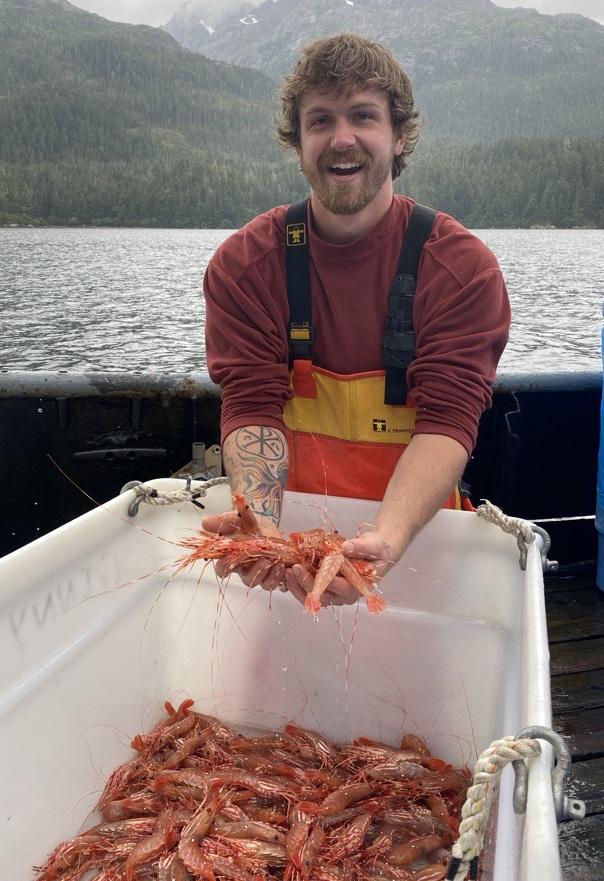
What would you say to anyone who wants to get into fishing?
Go and do it! There seems to be a lot of boats out there looking for deckhands. It’s a great opportunity you’ll see and learn plenty of cool stuff along the way. I would be so happy to see more people in the next generation jump into the commercial sector.
You eat a LOT of fish. What are your favourite ones to eat?
Tuna, specifically Bigeye Tuna, is hands down my favorite fish to eat. But when I moved over here to Australia, I was exposed to many species I had not had before or were otherwise hard to find. I now find myself eating a lot of Swordfish and King Prawns and I love cooking up grilled Octopus in the summer.
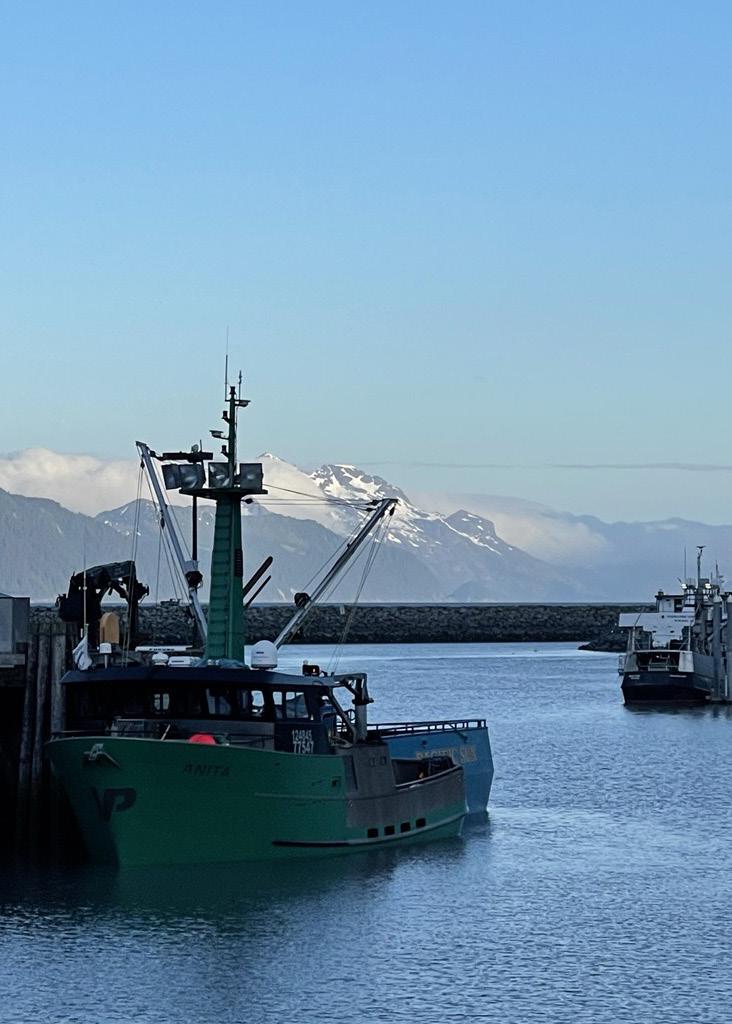
Want a behind-the-scenes look at Australia’s home of seafood?
Scan the QR code to explore our tours, and join Mike as you get a glimpse of Sydney Fish Market in action.

sydneyfishmarket.com.au
Winter The
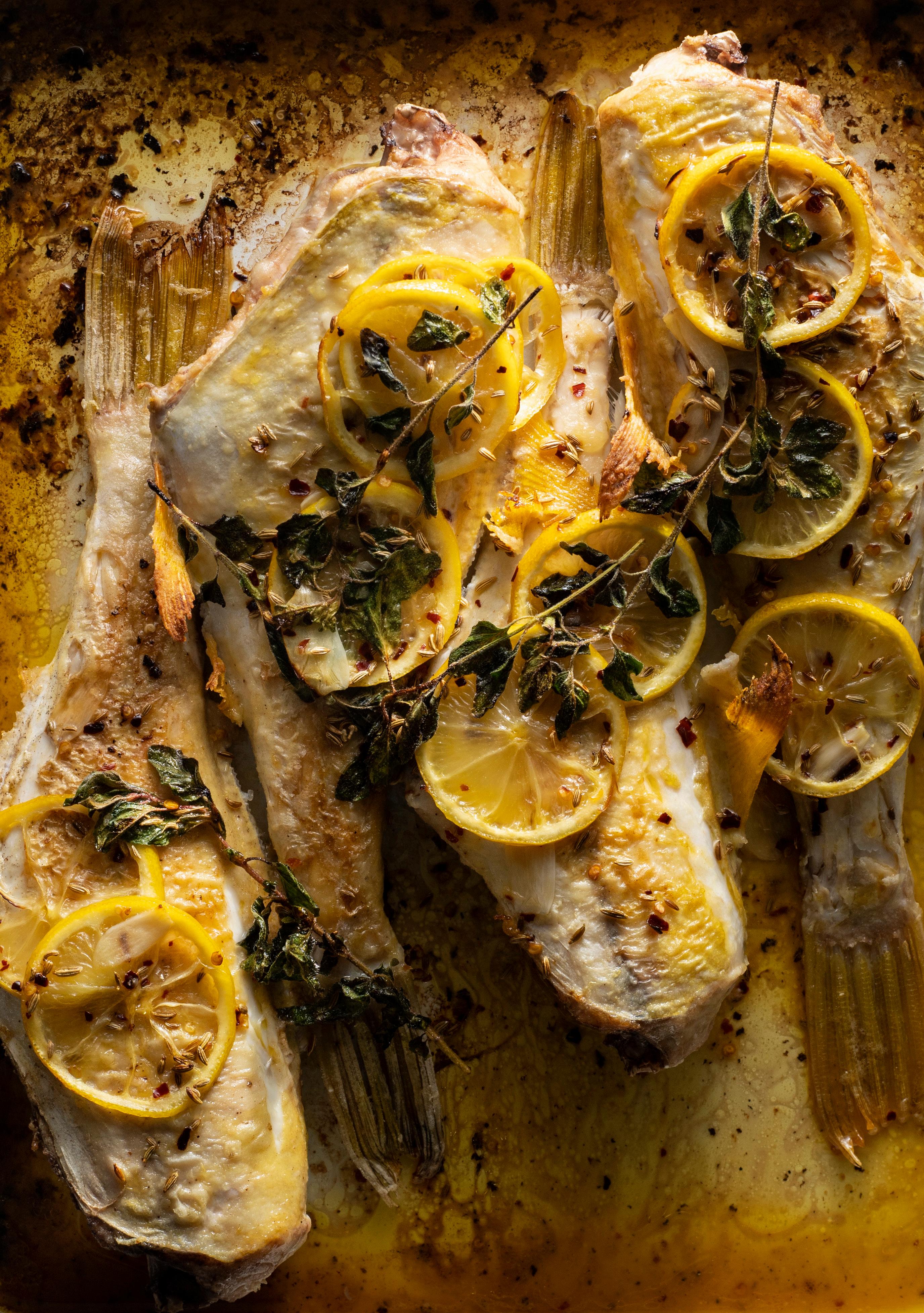
Recipes to Keep You Cosy
These recipes are taken from A Fish for All Seasons, the official Sydney Fish Market cookbook ($59.95). Available online at sydneyfishmarket.com.au.
WHOLE OCEAN JACKET WITH ROASTED LEMON, FENNEL & OREGANO
SERVES 4
½ cup plain flour
Salt flakes and freshly ground black pepper, to taste
4 x 300-350g Ocean Jackets, skin & head removed
2 lemons
¼ cup extra virgin olive oil
2 teaspoons fennel seeds
1 teaspoon chilli flakes
3 garlic cloves, sliced
60g butter
½ bunch oregano, sprigs and leaves
1. Preheat oven to 220°C (fanforced).
2. Season flour with salt and pepper and place onto a flat plate. Dust Ocean Jackets evenly in flour, shaking off excess.
3. Heat half the oil in a large frying-pan over medium-high heat. Add the fish and cook 3-4 minutes on one side only. Transfer to a shallow roasting dish, browned side up.
4. Return frying pan to mediumhigh heat and add remaining oil, fennel seeds, chilli and garlic. Cook for 1 minute, stirring often to prevent the garlic burning.
5. Slice one of the lemons and add to the pan along with the butter. Allow butter to melt and foam but not brown. Quickly add the juice of the remaining lemon and oregano sprigs.
Season with salt and pepper and pour immediately over fish.
6. Transfer baking dish to oven and bake for 10 minutes. Serve hot.
NOTES & TIPS • Your fishmonger can remove the thick outer skin of Ocean Jacket for you.
Ocean Jackets are almost always sold as trunks (with heads removed).
ALTERNATIVE SPECIES • Mirror
Dory, Snapper, Whitings.
NOTES & TIPS • Tamarind is sold as a puree in a jar and is ready to use. It is also sold as a compressed cake of pulp in a sealed packet. This form needs to be soaked in hot water to strain out the seeds.
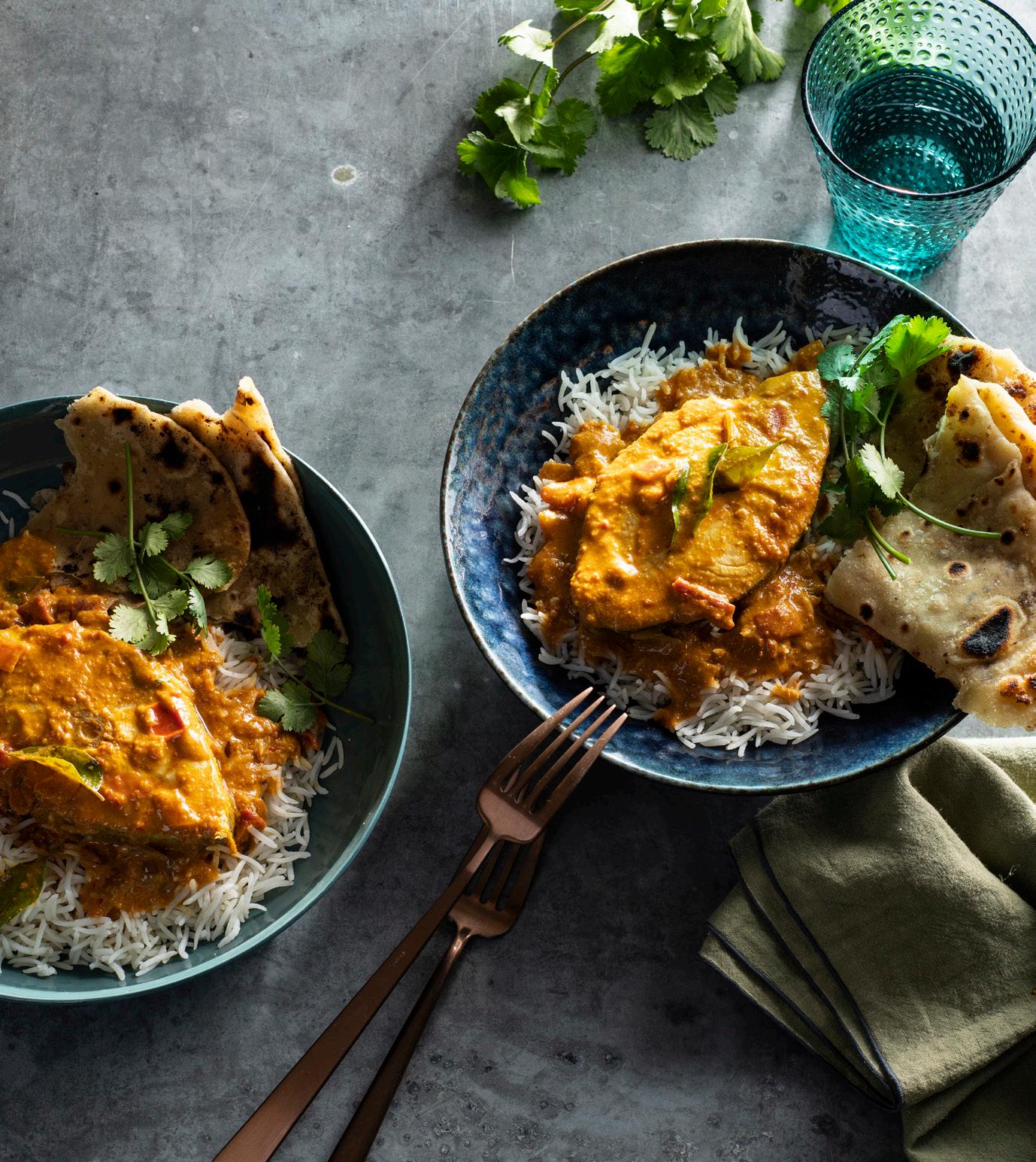
GOAN STYLE FISH CURRY
SERVES 4
CURRY PASTE
3 long red chillies, seeded and chopped
4cm knob fresh ginger, chopped
6 garlic cloves, chopped
1 tablespoon ground coriander
1 teaspoon ground cumin
½ teaspoon ground turmeric
1 teaspoon salt
400ml can coconut milk
GOAN FISH CURRY
4 x 2cm thick Grey Mackerel cutlets
Sea salt to taste
2 tablespoons vegetable or coconut oil
1 red onion, chopped
12-14 curry leaves
1 long green chilli, split lengthways
1 tomato, diced
1-2 tablespoons tamarind puree
Chopped coriander to garnish
Steamed basmati rice or flat breads to serve
1. Curry Paste: Place all curry paste ingredients and coconut
milk into the bowl of a food processor, or use a stick blender, and process ingredients into a loose wet paste. Set aside.
2. Goan Fish Curry: Season both sides of fish with salt and set aside while making the curry.
3. Heat oil in a large heavybased pan over medium heat and cook onion and curry leaves for 3-4 minutes, or until onions have softened. Add chilli and tomato and continue cooking until tomato has collapsed and broken down.
4. Stir in curry paste and salt and fry for 2 minutes, stirring continuously to cook out the spices. Add tamarind puree and ½ cup of water. Start by adding 1 tablespoon of tamarind puree to curry. Taste and add more if needed, as you may not need it all. Bring to a simmer and cook for 5 minutes.
5. Slide fish cutlets into the curry and simmer gently for 10 minutes or until fish is cooked. Garnish with coriander and serve with steamed rice or flatbread.
ALTERNATIVE SPECIES • Bonito, Spanish Mackerel, Swordfish.
Find Your Flavour
Meet The Chefs
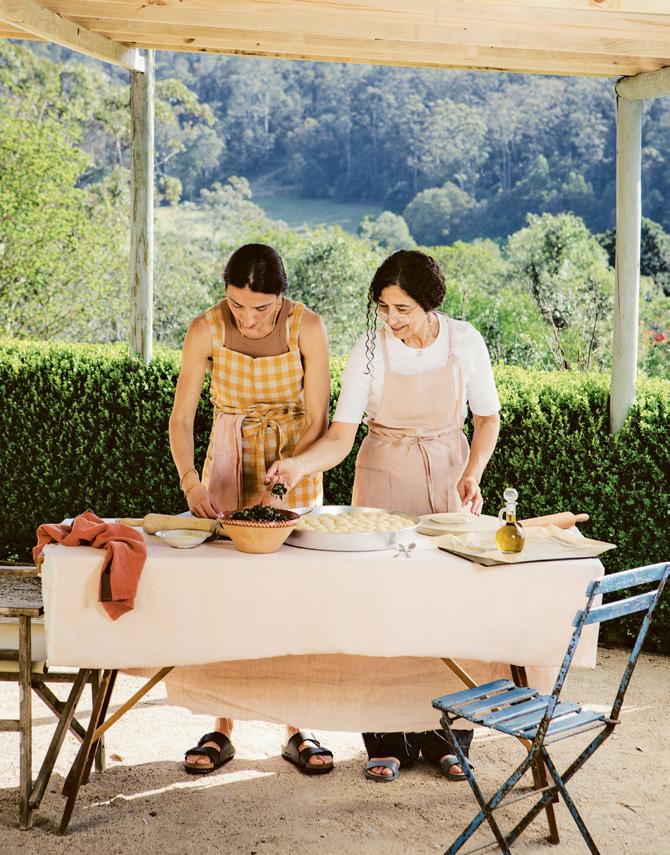
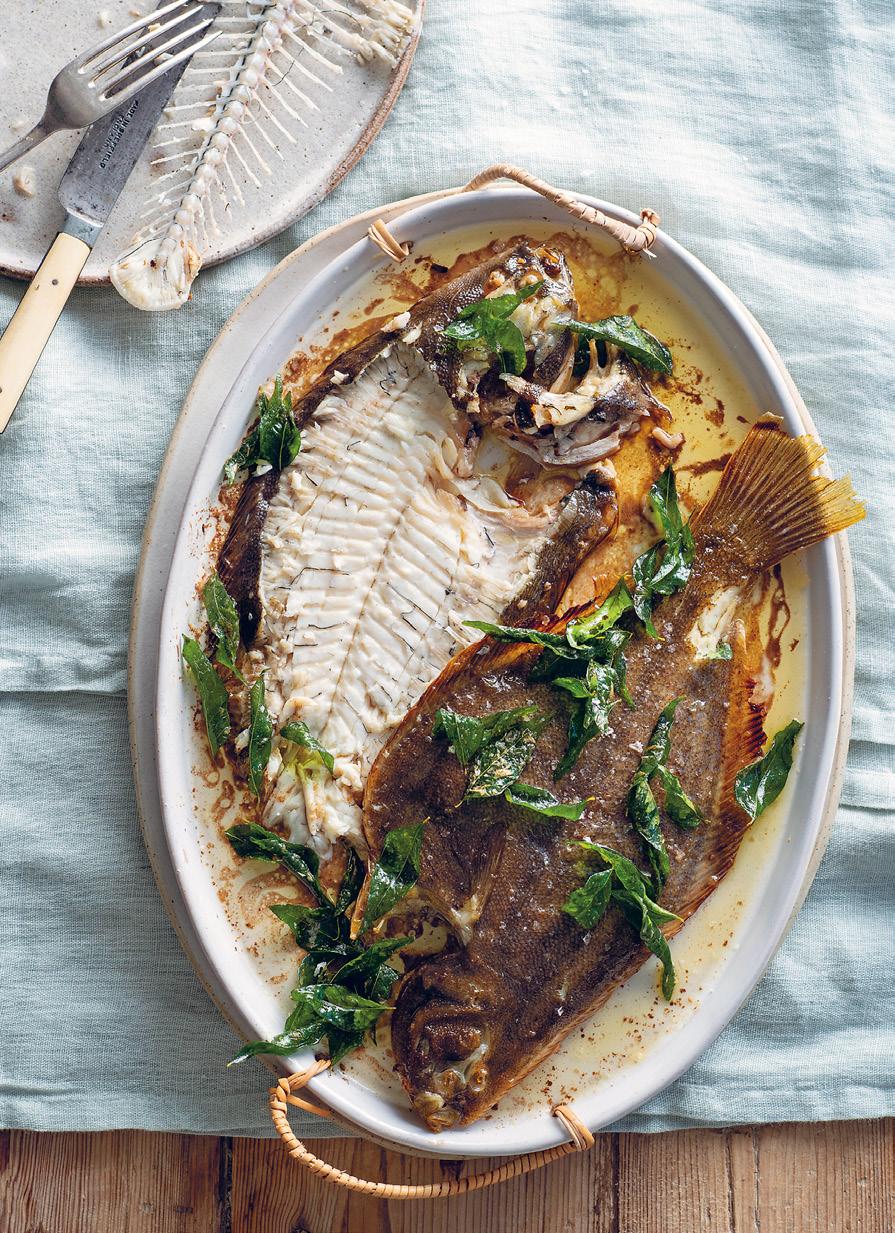
Sunday Kitchen’s Karima Hazim Chatila & Sivine Tabbouch
We kick off with Karima Hazim Chatila and her mother Sivine Tabbouch, the founders of Sunday Kitchen and the authors of the exquisite book Sofra: Lebanese recipes to share. Together Karima and Sivine share the joy, skills and timeworn traditions of Lebanese cooking. For this class they’ll be showcasing (and you’ll be cooking) a mouthwatering Lebanese seafood feast.
JULY 05
Michael Rantissi
One of our most popular presenters, Michael Rantissi is returning to Sydney Seafood School to launch his new book Salata, which showcases meal-in-themselves salads that draw on Greek, French, Italian, Spanish, north African and Middle Eastern culinary traditions. This class will be a first look at Salata and will appeal to pescatarians and vegetarians alike.
· SEPTEMBER 03 ·
Simon Sandall
The creative force behind Gladesville’s much-loved neighbourhood eatery Boronia Kitchen is bringing his special touches and chef’s hacks back to Sydney Seafood School. Add a dusting of magic to your winter dinner parties and your weeknight meals with Simon’s clever and delicious recipes.
· AUGUST 13 ·
The Sydney Seafood School winter class schedule is now live, and we think you’re going to love it. There’s something for everyone, whether you’re looking for seafood focused cooking inspo or to glean tips and tricks from some of the best chefs and cookbook authors around.
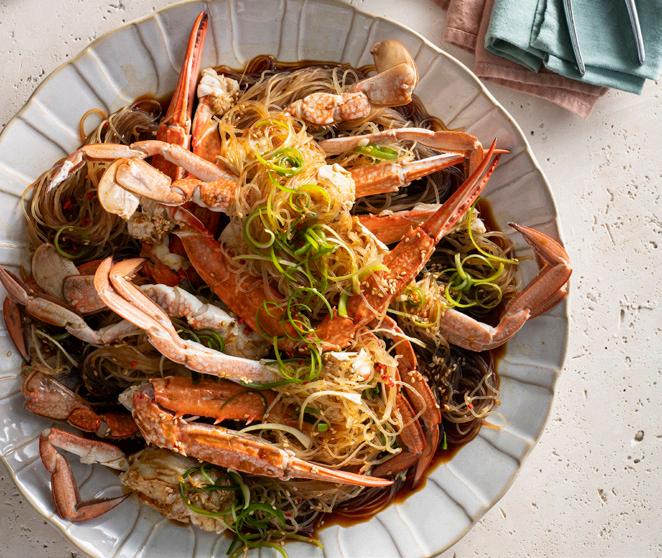
First Nations Seafood Feast W/ Luke Bourke and NICI
We’re delighted to welcome back Good Food Guide Young Chef of the Year Luke Bourke and National Indigenous Culinary Institute (NICI) for a First Nations Seafood Feast. Luke will be cooking with the original native food – seafood – and will show us how to create superb midwinter dishes using other ingredients such as native pepper berry, Davidson’s plum, lemon myrtle, saltbush and warrigal greens.
· JULY 26 ·
Danielle Alvarez
Acclaimed chef Danielle Alvarez, Culinary Director at Sydney Opera House, will be bringing something old and something new to this hotly anticipated class, with recipes from her current book, Recipes for a Lifetime of Beautiful Cooking, and a sneak peek at her new book, to be published in early 2026. You’ll come away with techniques that ensure your meals are always full of flavour and you’ll understand why beautiful cooking is the simplest way to bring happiness to any home.
JULY 05
Seafood & Spice: Indian Regional Cooking W/ Bhavna Shivalkar
Favourites Global
Bouillabaisse
Cooler weather calls for warming soups and stews and for us that means Bouillabaisse. The traditional Provençal fish stew originated in the 18th century, and was first eaten by Marseillaise fishermen, who would combine the leftovers of the daily catch into a delicious and nutritious soup. It has since evolved into one of the world’s most luxurious seafood dishes. Learn how to make it using the freshest and best seafood from Sydney Fish Market.
JULY 13
Skill Up
Fillet-A-Fish
This class will teach you everything you need to know about filleting a fish: what tools you need, what kind of fish to buy, how different shaped fish need different treatments, and a host of essential filleting techniques.
· JULY 19 ·
And don’t forget our perennially popular classic classes. They are guest favourites for good reason.
Bhavna Kalra Shivalkar is the oracle on all-things Indian home cooking. She has a deep knowledge of the spices and essential ingredients that are the cornerstone of regional cooking from Kerala to Rajasthan to Punjab. Bhavna will share stories and anecdotes about her homeland, and clever tips and tricks that demystify Indian cuisine.
JULY 31
Seoul Food: A Taste Of Korea
Embark on a culinary journey to the Land of the Morning Calm. We’ll introduce you to the vibrant and exciting flavours of Korean cuisine and the essential ingredients you’ll need to create delicious and authentic dishes such as spicy octopus (which KBBQ fans will love) and the famous Korean seafood pancake.
· AUGUSUT 16 ·
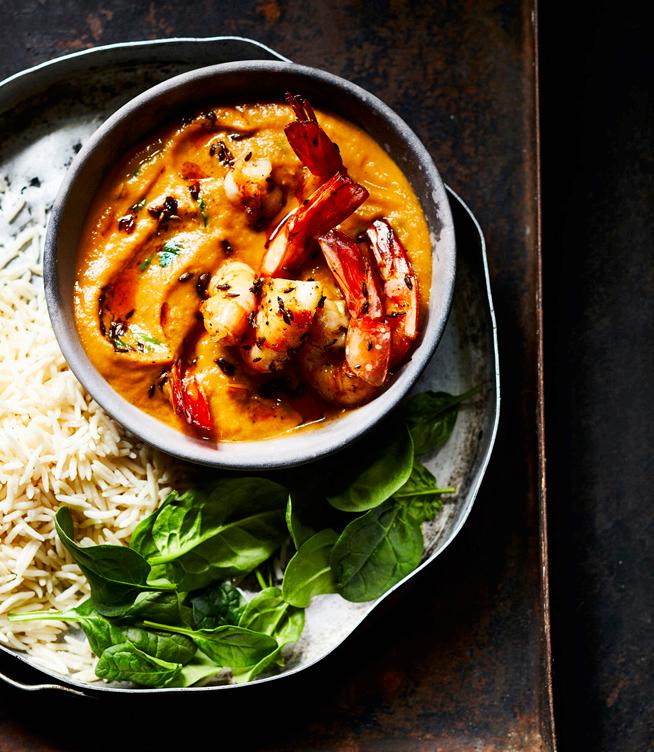
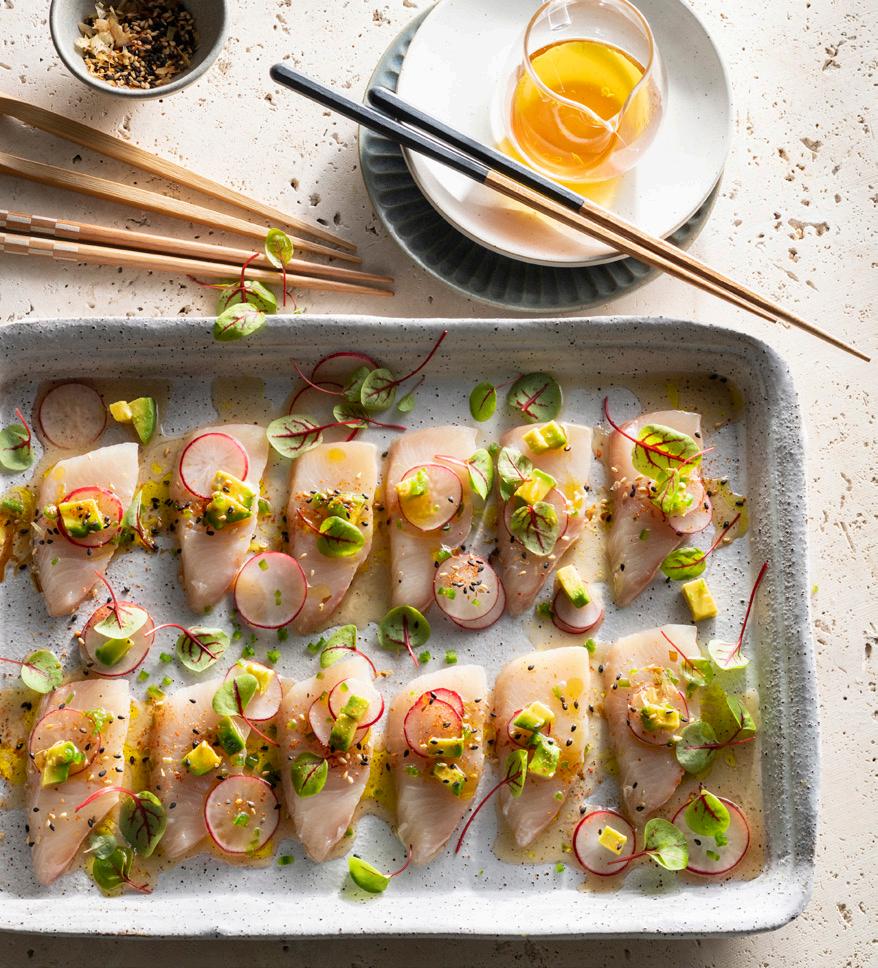
The Raw And The Cured
This is your chance to learn all about choosing, preparing and eating sashimi-grade seafood. Prepare to handle new species, possibly things you’ve never heard of; we source the freshest and best catch daily from Sydney Fish Market. You’ll be slicing and dicing like an expert in no time as you prepare a menu of all-raw seafood dishes.
AUGUST 02
Mediterranean Odyssey
Singapore Chilli Mud Crab
Spanish Paella A Taste of South East Asia
Seafood BBQ
Italian Seafood Feast
Seafood Specialist
One of our classic classes, and also one of our most popular, Seafood Specialist combines skilling up –you will learn to fillet a fish, clean a squid and prepare a Blue Swimmer crab – with delectable but simple recipes you are guaranteed to have on repeat. This class has something for everyone.
· JULY 19 ·

sydneyseafoodschool.com.au Scan here to explore the full schedule.
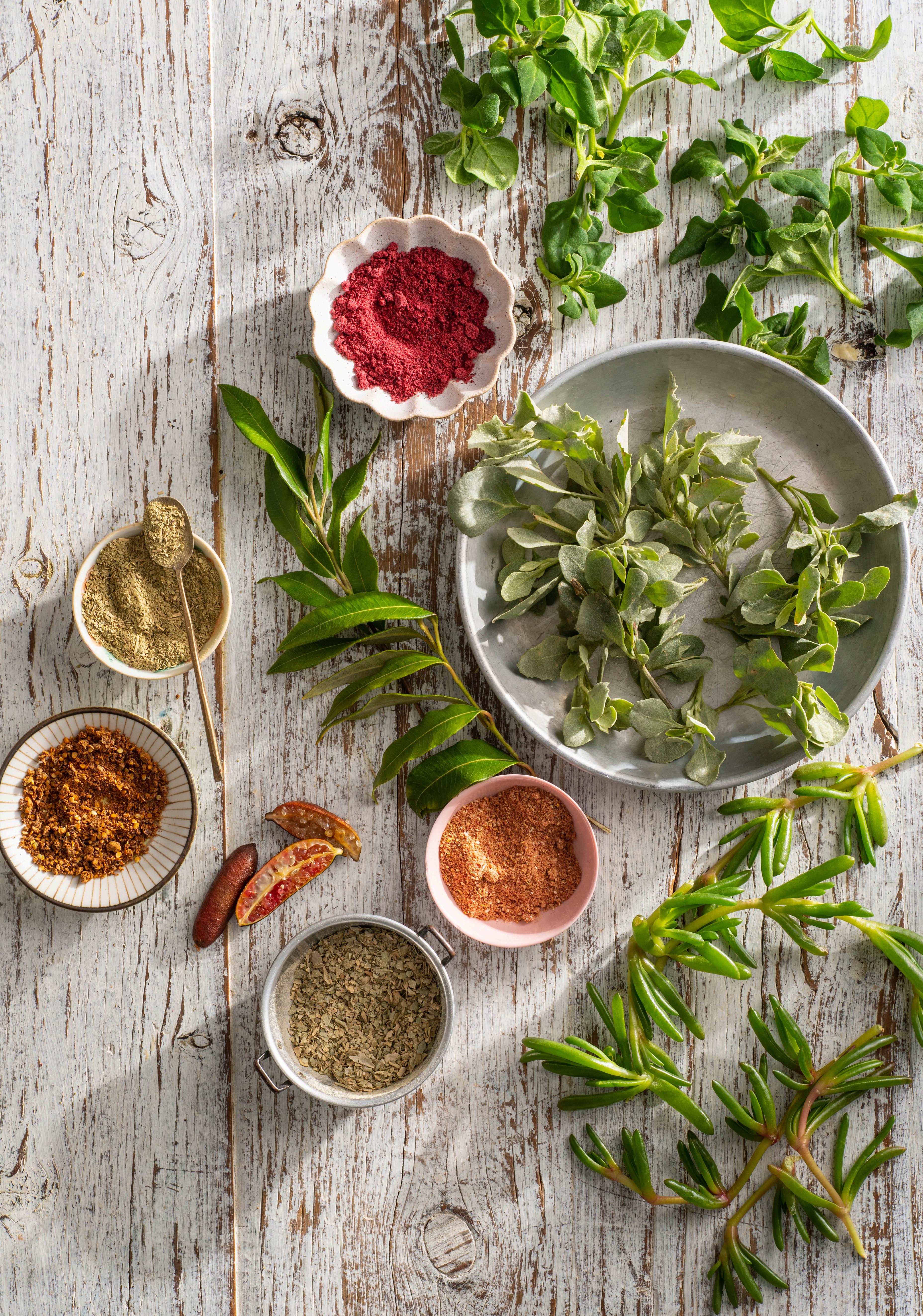
AUSTRALIAN NATIVE INGREDIENTS
And How To Use Them
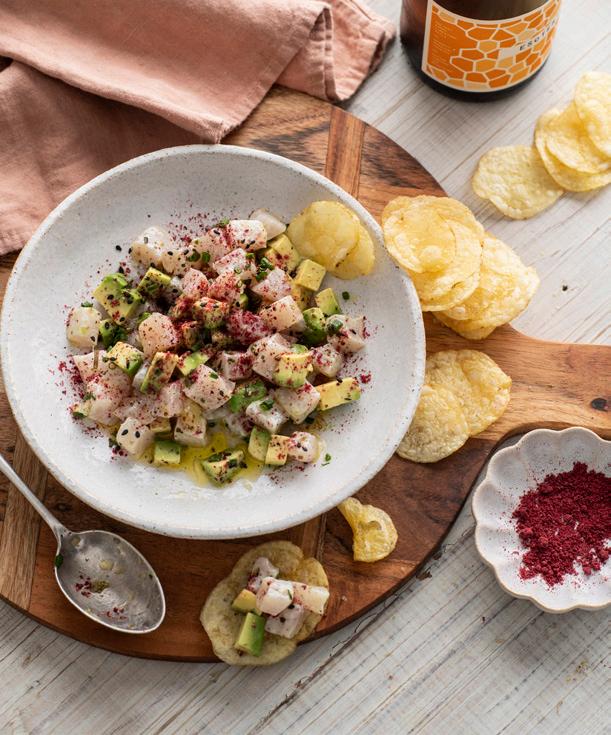
From saltbush to finger lime and lemon myrtle to warrigal greens, here are a few of our favourite native things.
DAVIDSON’S PLUM
Most commonly found in Queensland and northern New South Wales, Davidson’s plum has a bright purple skin and vibrant magenta-hued flesh. The fruit is very tart rather than sweet and makes great jams and sauces. You can buy them fresh, frozen or as a freeze-dried powder.
LEMON MYRTLE
Probably the best known of Australia’s native ingredients, lemon myrtle is a native
rainforest plant but is easy to find in suburban streets and gardens.
Use it either fresh (young leaves are best for this) or dried where you might use lemon or even bay leaves. Dried leaves are ideal for teas and in cooked sauces, such as a lemon myrtle beurre blanc.
ANISE MYRTLE
This native rainforest plant grows in the subtropical rainforests of northern NSW. The leaves have a strong liquorice flavour. Anise myrtle adds a subtle aniseed flavour to baked goods, like fruit cake or mince pies, and can be bought and used fresh or dried.
SALTBUSH
Saltbush is a fast growing shrub that grows all over the country. It’s available fresh – you can chew on the fleshy leaves - or dried and ground into a powder (which works well as a salty seasoning). We love it in our chilli saltbush dipping sauce, with dumplings.
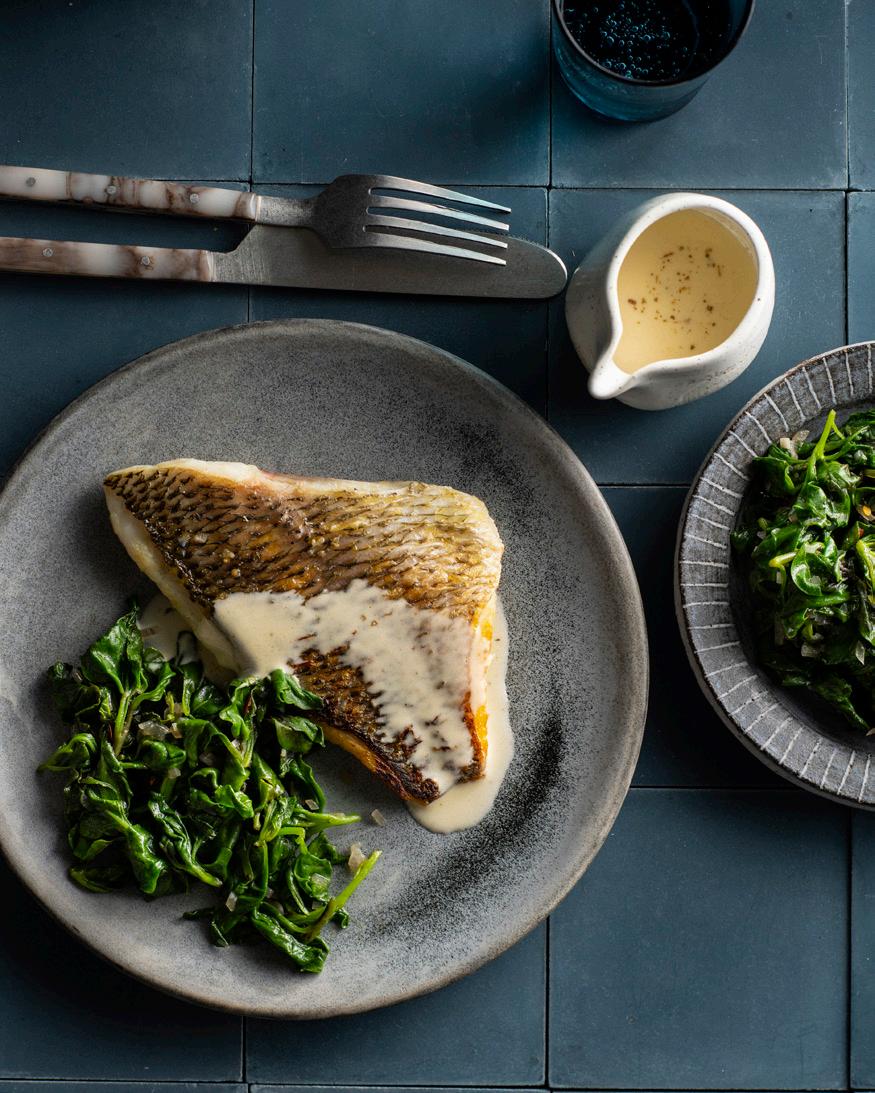
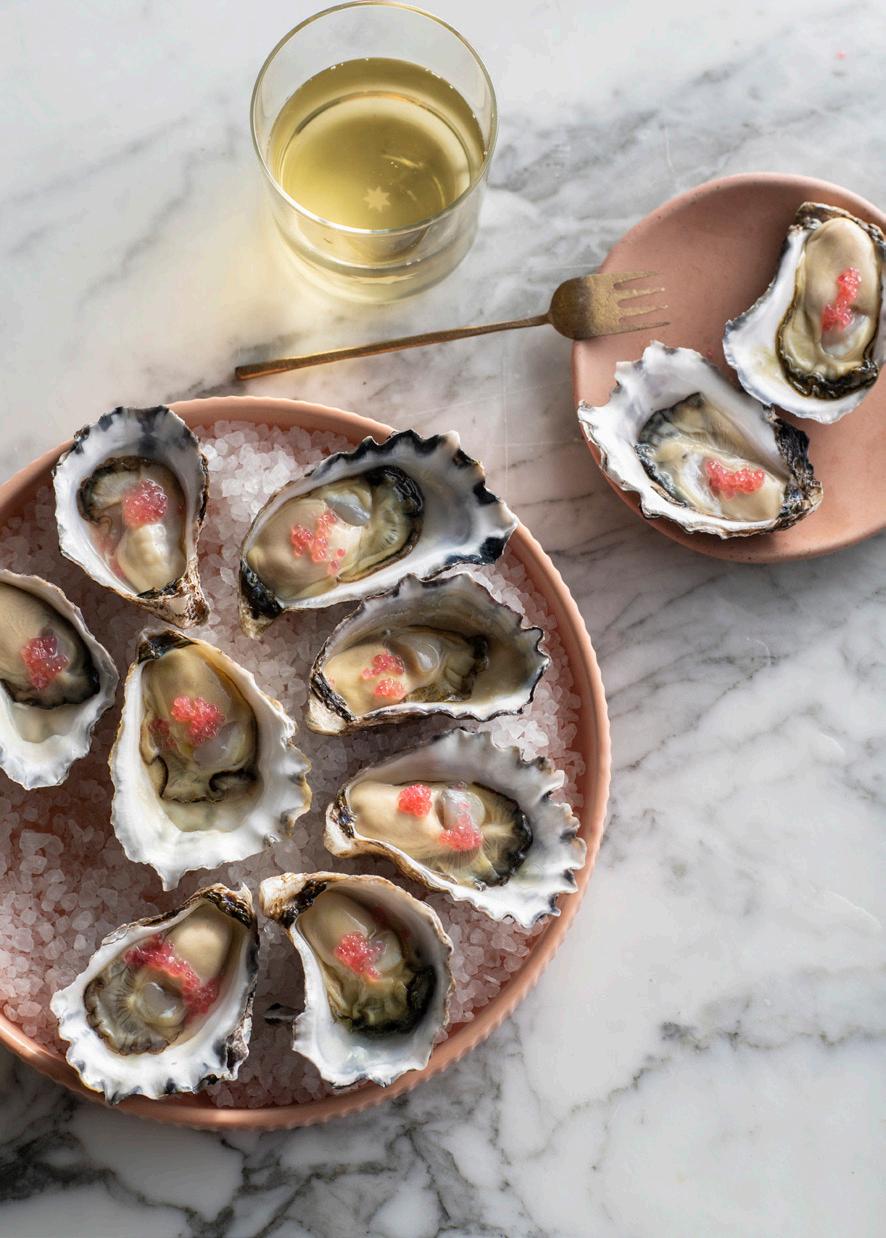
FINGER LIME
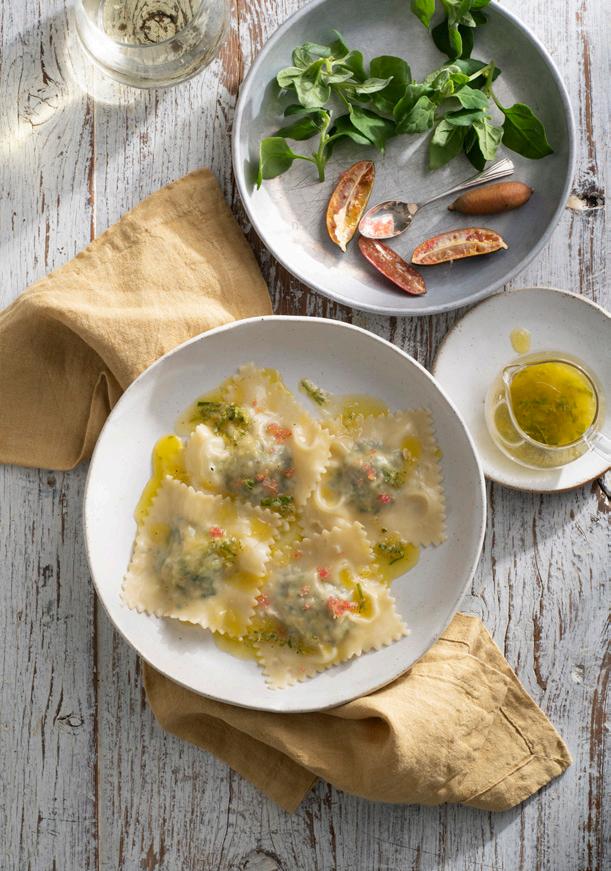
WARRIGAL GREENS
So versatile, warrigal greens can be used like you might use silverbeet, spinach or bok choy. Warrigal greens are easy to grow, often foraged and increasingly farmed. Choose younger leaves which are less bitter than older ones.

The small fruit grows on a spiky plant and comes in a variety of colours, from deep red to bright green. Each fruit contains small lime pearls, also called lime caviar, which chefs love. The pearls are wonderful as a garnish on freshly shucked oysters, freshly grilled fish, or in a gin and tonic. If you want to know more about how to use native ingredients join us at Sydney Seafood School for our First Nations Seafood Winter Feast class with Luke Bourke and the National Indigenous Culinary Institute.
Scan above to book, or visit sydneyseafoodschool.com.au for more information.
We are drawing ever closer to our move to the spectacular new Sydney Fish Market, due for completion later this year!
Fish market visitors can get a front row seat to witness the construction of the new site as it receives its finishing touches. What most people are first struck by is the sheer scale of the new building. Fortunately, all that extra space means we can welcome an array of impressive new eateries and specialty food retailers.
Here’s an introduction to the new Sydney Fish Market retailers who will join existing SFM favourites at our new home.
Leyrd will offer Vietnamese street food with a focus on fresh salads, rice paper rolls and the best Banh Mi. Hailey Nghiem and Charlie Dinh both have an impressive pedigree, having worked at some of Sydney’s top establishments and are setting up their first venture at the new Sydney Fish Market.
Long Johns will be a casual eatery, where lobster, burgers and craft beers will dominate the menu. It is inspired by Southern USA and the East Coast of Australia, featuring ‘Po’ boys’ which is a style of hot sandwich from Louisiana.
Cow & The Moon are an awardwinning family run, artisan
gelateria with a range of ice cream cakes, great coffee, and the best gelato.
Inner West institution Dirty Red will open two outlets at the new site. Their new all-day dining concept will be called “touch_wood” and will feature a broad menu focusing on seasonal, local ingredients. The team will also open Little Red Wine Bar, the market’s first small bar, specialising in a great array of cocktails and wines by the glass, with shared small plates of delicious charcuterie.
Doltone Hospitality Group are partnering with chef Luke Nguyen again to create a flagship Southeast Asian Restaurant, Lua Restaurant & Bar. Luke is a celebrity chef, author, restauranteur and TV presenter with an enormous following both in Australia and internationally.
Efendy offers contemporary Turkish cuisine by award-winning Master Chef judge Somer Sivrioglu. Guests will be spoiled for choice with an array of authentic Turkish dishes cooked over charcoal and a mouthwatering mezze bar.
Gotcha Fresh Tea farm their own tea in Mount Ali, Taiwan and offer a unique product in the Australian market, freshly brewed for each individual order.
Green Valley Goes Nuts for fresh nuts, herbs and spices and will provide a wide range of packaged and freshly roasted specialty products for those that love to cook, eat, and entertain.
Tam Jiak by Ho Jiak brings Junda Khoo’s award-winning flavours to the fish market to celebrate all things Malaysian food.
Le Dea Pizza is headed by chef Gina Spaziani, serving pizza by the slice and Italian wines by the glass.
Luneburger is an authentic German bakery offering freshly baked daily goods such as specialty breads and rolls, kaiser, pretzel, lysticks, and ciabatta, as well as freshly made sandwiches, great coffee, and sweet treats.
Mayfarm Flowers will be the first retail store for the May’s family-owned flower business, with beautiful flowers grown on their farm just outside Orange.
Mani offers a modern take on Asian Fusion cooking with diners treated to an array of delicious Asian inspired dishes.
Nanjing Dumplings will feature both traditional and specialty dumplings and one of the only places in Sydney to experience Nanjing-style xiao long bao, a doughier and slightly sweeter version of Shanghai’s most famous soup dumplings.
Olivetta is Sydney’s first specialty Olive Oil concept store, featuring a variety of olive oils, vinegars, and beautiful olive oil-based soaps and body products.
Open Sesame will bring authentic Lebanese Street food, affordable casual dining, and mouth-watering options to the markets.
Considered by many coffee aficionados as the best roasters in Sydney, Stitch Coffee has a passionate and creative team, sourcing coffee from around the world, connecting customers with coffee producers. Paired with their beautiful range of coffees with be a number of Stitch signature bowls, toasties, pastries and baked goods.
Sergio will deliver the ultimate European style patisserie, serving beautiful handmade, cakes, pastries, and biscuits. High tea will be served daily.
Ichie will offer ramen, donburi, seafood BBQ and a sake bar, backed by Hidetoshi Tsuboi, Libras Ting and Takeo Muramoto, who between them are responsible for delivering some of the most awarded Japanese concepts in Sydney and Japan.
Top Juice works with Australian farmers and suppliers to source the freshest fruit and vegetables to create delicious, healthy and convenient juices and salads.
For more updates on the new Sydney Fish Market, visit newsydneyfishmarket.insw.com
6 Ways To Enjoy Whole Fish At Sydney Fish Market
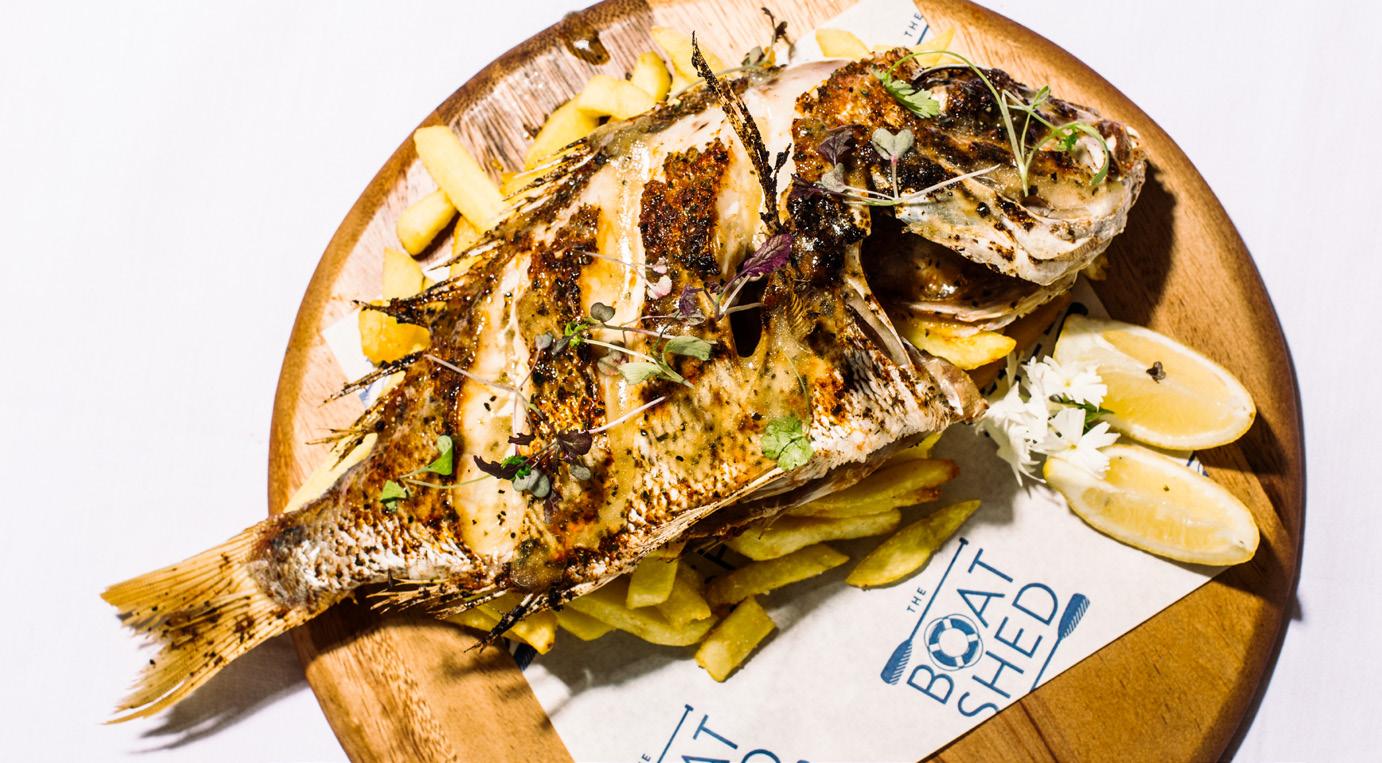
There’s nothing quite like the experience of eating a perfectly cooked whole fish: tender flesh, crisp skin, and full flavour. At Sydney Fish Market, there are plenty of ways to get your hands on the freshest whole fish, whether you want it cooked to order, enjoyed straight from the grill, or prepped and ready for you to finish at home. Here are six delicious ways to dive in.
1. Cooked to order from Christie’s Seafood
Feeling peckish? Head straight to Christie’s Seafood, where you can choose your fish from their glistening displays and have it cooked to your liking. Whether you prefer a sauce of ginger and shallot, X.O, garlic butter or salt and pepper (just to name a few) the team will prepare it fresh while you wait.
2. Fresh off the grill at Fish Market Café
For a laid-back meal, Fish Market Café is a go-to. Their whole grilled fish plates are hearty, flavourful, and perfect for sharing. Pair a whole grilled Barramundi or Snapper with chips and salad for a true Aussiestyle lunch or opt for a steamed version for a lighter take. A great no-fuss option, it’s easy to grab your food and then a spot outside to enjoy your seafood with waterfront views.
3.
Traditional flavours at Nicholas Seafood
Over at Nicholas Seafood, you’ll find an impressive selection of both ready-to-eat and cookedto-order seafood – including their famed whole fish offering. The best part is you can choose your own fish from the huge array of seasonal seafood species in the retail display. Stick with the traditional favourites like Snapper or Barramundi or branch out and try something more unusual like Alfonsino, Ocean Perch or Scorpionfish. Once you've chosen your fish, you can select from a range of cooking styles. Our top recommendation is Asianstyle steamed fish packed with fresh herbs, ginger, and soy. A fragrant, mouth-watering option for those who love bold flavours.
4. A take-home treasure from Claudio’s Seafoods
Prefer to try your hand at home cooking? Claudio’s Seafoods offers a fantastic range of whole fish, scaled, gutted, and ready for your oven, grill, or barbecue. Their knowledgeable staff can help you pick the perfect species for your recipe, from little fish heroes like Sand Whiting and Yellowtail Scad to a perfectly pan sized whole Flounder. They can even offer tips on seasoning and cooking techniques to get the best results.
5. Dine in at The Boatshed
For something a little special, grab a table at The Boatshed Pyrmont. Their menu champions premium local seafood prepared in a variety of styles. The market fish selection, often featuring John Dory, Coral Trout, Murray Cod and more, is a true highlight, with the option to have it steamed, grilled or fried, depending on your preference. It’s all about letting the quality of the fish shine. Perfect for a relaxed brunch or a long lunch with friends.
6. Learn to master whole fish at Sydney Seafood School
If you’d like to really build your confidence with whole fish, why not join a class at Sydney Seafood School? The popular Fillet-a-Fish class is perfect for beginners looking to learn the basics of filleting and preparing fish, while the Seafood Specialist class takes things a step further, teaching more advanced techniques, including how to select, prepare, and cook whole fish. It's a fun, hands-on way to learn, with expert advice and plenty of delicious seafood to sample along the way. Find out more and book your spot at sydneyseafoodschool.com.au.
From the auction floor to Sydney Seafood School, Sydney Fish Market team members know their stuff when it comes to seafood, we picked their brains for you...
IN A
What’s your favourite way to cook seafood in winter?
I absolutely love cooking up scallops with garlic butter and serving them on a bed of mash potatoes with veggies, although it’s not something I recommend eating all the time. If not, a delicious prawn laksa is always perfect in winter.
- Erin, Finance
When it’s cold, I love a warming and filling dish. Prawn and chorizo risotto, baked in the oven and finished off with herbs and a generous squeeze of lemon has got to be my fav.
- Alexandra, Marketing
I love chowder type recipes with hot creamy sauces-preferably marinara, pipis or clams.
- Peter, Seafood Trading
What is one dish at Sydney Fish Market you think every visitor should try?
I think the truffle toasties at Blackwattle Deli are amazing, but you have to LOVE truffle. For seafood, I enjoy the freshly cooked squid legs in spicy salt from Christies.
- Erin
I’d be lying if I didn’t say the sushi selection at Sushi Bar wasn’t my everyday go to! Whether you want a basic roll or a mixed selection, it never disappoints.
- Alexandra
I love the BBQ Octopus The Boatshed offers. I always get the main size. The honey crumbled feta drizzled on top of it is the star.
- Peter
What is your favourite seafood species, and why?
Moreton Bay Bugs - there is something about these guys that make you feel a little fancy when enjoying the sweet flavour. The firmness of the flesh makes it perfect for all sorts of recipes (I love them on the BBQ or in a chilli oil pasta), they tend to be available all year round and they are a great seafood when impressing guests.
- Erin
Yellowtail Kingfish - it’s so versatile.
It’s delicious grilled as a fillet with crispy skin, fried as collars served with aioli, or sliced raw as sashimi with a ponzu dressing. It pairs nicely with the simplest of flavours.
- Alexandra
Flathead- nothing better than a crumbed piece of deep fried Flathead at anytime during the year.
- Peter
Want to hear more from our Seafood Experts?
Check us out on TikTok!
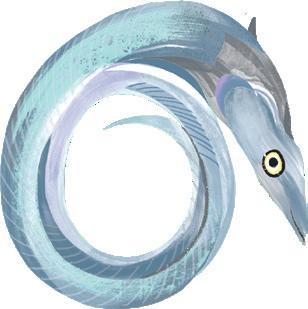
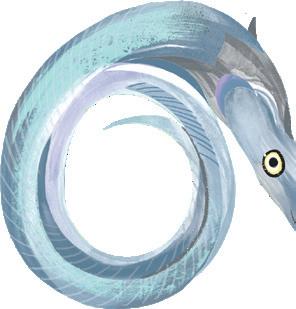
WANT MORE?
Follow us on social media @sydneyfishmarket or visit our website sydneyfishmarket.com.au
Sydney Fish Market is located on the traditional lands and waters of the Gadigal and Wangal people, who have lived and fished here for tens of thousands of years. We acknowledge the traditional custodians of this site and pay respect to Elders past and present.
